Holocaust Documents
Written by SirAaronRichards, mirrored here because he posted his article on Imgur, which is an image sharing site that isn't ideal for text, as scrolling is a hassle and the text doesn't show up in Google search results. I have renamed (SEO) but not resized the images. I have fixed broken hyperlinks, corrected some typos, and re-inserted captions.
I have also mirrored his Debunking "Adolf Hitler: The Greatest Story Never Told" and his second part of the Holocaust Documents series titled Debunking Denial.
I have collected the most important 50+ German documents and quotes here: English translations. Also see: The Goebbels Diaries.
Not in the mood for reading? Watch one of the relevant video's.
Aaron introduces himself as follows: "I am Aaron Richards, hobby history buff, science student, political centrist, atheist, European, youtuber and /pol/ack. A combination of being called a Jew due to my username and encountering theories on said browsing mediums combined with my own love for history led me to the rabbit hole of holocaust research. Refuting 40 years of antisemitism can be a laborious, but rewarding and fun task, as you will find out in my Holocaust Documents album. Historians might be far more accurate than I am in my blog, but they need to step up their game and offer interactive debunking websites or it'll be up to poor sods like me to offer illustrated rebuttals to internet conspiracy theories for the general public."
Aaron writes:
Let me begin by telling you a little bit about myself, and what made me create this blog for free during my spare time over the course of several months. See, I have been interested in history since I was a 12 year old boy. But after finishing compulsory education, I decided to dedicate myself to the sciences instead, and partly also motivated by the higher demand in the job market a STEM degree offers. However, my interest in history remained. At the same time, I have been active on youtube almost since its conception in 2005, and therefore what shocked me most is when I started coming across an increasing barrage of holocaust denial videos on that website in the past year or two, as well as increasing troll accounts (e.g. "Shlomo Shekelstein") posting their denial in the comments section of even non-holocaust related WW2 or political videos. I took personal offense not just because these people were slandering the death of 11 million* human beings (I use Simon Wiesenthal's figure as an approximate, the real total of all deliberately targeted Jewish and non-Jewish civilian or disarmed victims by the Nazis is likely higher), but also because they attacked not just historiography (and by implication all historians involved), but also our entire world view, everything we believe in, and everything we have been taught our entire life. Naturally, I was intrigued like just about anyone else, and watched their "documentaries", but while others might have had an "eye opener" moment that confirmed their inner xenophobia and turned them into holocaust deniers, watching these denial videos only made me more aware of how much fact-twisting and lies these "revisionists" did to present their theories, whose ultimate goals are not scholastic (correcting an erroneous historical record), but rather political in nature, namely whitewashing National Socialism in an effort to rehabilitate it, promoting White Nationalism and calling for another Jew-hunt ("Jews run the media, hence you're brainwashed, time you wake up and do something about it").
I began to research more and more about the holocaust from legitimate sources (books by historians, original documents, photos, census data, victim testimony, perpetrator testimony etc.), and all it did was reaffirm my conviction about the historicity of this event rather than shatter it. Therefore I decided to do my part in dedicating this blog to set the record straight, as best as I can.
The only thing I have to agree with holocaust deniers is that indeed, researching about the holocaust (or any other historical event for that matter) is a rabbit hole. Depending on how far down you are willing to go (or your curiosity ends up taking you), your research will last for hours, days, weeks, months, years or even decades. My research took two years. And one thing I noticed, was that holocaust denial and holocaust acknowledgement are not two unified fronts clashing against each other, but that there are rifts and quarreling both among deniers, and defenders.
On the denier side, we have on one hand the active wing consisting of contributors to the holocaust denier echo-chamber and safe space known as the CODOH forum (the late Bradley Smith's Committee for Open Debate on the Holocaust, run by the admin Jonnie "Hannover" Hargis who makes an oxymoron out of the site's name, because open debate is NOT permitted on CODOH, as not only topics but even individual replies of new members are initially only allowed to appear on the site after approval; posts are deleted, even signatures he doesn't like are erased - therefore the acronym should really stand for Committee for Open Denial on the Holocaust); a dozen or so frequent revisionist posters on the RODOH forum (Real Open Debate On The Holocaust, created as a less policed alternative to CODOH), Carolyn Yeager "Elie Wiesel Cons the World", Gen Baugher (head of the "furtherglory" blog, and the innocuous appearing scrapbookpages), Jürgen Graf, Jim & Joe Rizoli, Carlos Whitlock Porter and his website, Michael Santomauro, Vincent Reynouard, Ursula Haverbeck and the more prominent figures Germar Rudolf (Rudolf Report) and Carlo Mattogno, with Rudolf now being the chief editor of the "holocaust handbooks" series (Castle Hill Publishers) that compiles and re-publishes all relevant (often decades old) denier material, and the latter a very active contributor to said material (I wonder if there's anyone who has read everything Carlo "quantity is a quality of its own" Mattogno has ever written apart from Carlo himself), as well as the people running the "Inconvenient History" blog;
then a more inactive wing consisting of Robert Faurisson ("No Holes, no Holocaust"), Arthur Butz ("Hoax of the Twentieth Century"), John C. Ball ("Air Photo Evidence"), Nicholas Kollerstrom, Ernst Zündel (Samisdat publications), Fred Leuchter (Leuchter reports), Walter Lüftl (Lüftl report), Richard Harwood/Verrall ("Did Six Million Really Die?"), Udo Walendy, denierbud ("One Third of the Holocaust"), Gerald Fredrick Töben ("Adelaide Institute"), as well as "on the fence" guys like James Bacque ("Other Losses") or the mysterious individual known as "Thomas Dalton, PhD" and many dead deniers such as Paul Rassinier, Harry Elmer Barnes, David Hoggan, Benjamin Freedman (infamous 1961 speech at the Willard Hotel), Thies Christophersen ("Auschwitzlüge"), Wilhelm Stäglich, Bradley Smith, Henri Roques, Walter Sanning ("Dissolution of European Jewry") and Willis Carto (former head of the Institute for Historical Review);
a "Jewish" wing consisting of holocaust deniers of Jewish ancestry (as if this makes them more legitimate compared to gentile deniers) such as alternative medicine guru Roger Dommergue, famous violinist Yehudi Menuhin's enfant terrible son Gerard Menuhin ("Tell the Truth and Shame the Devil"), Nathanael Kapner ("Brother Nathanael" on YouTube) and David Cole (though today he accepts most of the holocaust happened, such as Aktion Reinhard);
a wavering wing that is starting to question their former revisionist positions, consisting of David Irving, "The Black Rabbit of Inlé" and his "Winston Smith Ministry of Truth" blog, Eric Hunt and Mark Weber, all beginning to accept certain facts of the holocaust as legitimate, such as several million victims being the combined result of Einsatzgruppen massacring innocent civilians and homicidal gassings at the Aktion Reinhardt extermination camps Belzec, Sobibor, Treblinka, Majdanek and Chelmno with Mark Weber even being the head of the IHR (Institute for Historical Review), denier central, as well as people who started out as holocaust deniers and ended up wholly realizing their erroneous beliefs, such as Charles D. Provan or Jean-Claude Pressac, whose "Auschwitz: Technique and Operation of the Gas Chambers" only ended up becoming an extensive collection of documents underscoring Auschwitz's homicidal nature;
and then we have Friedrich Paul Berg, who is an active denier but has made himself many enemies in the denier scene, especially Robert Faurisson, as Berg believes mass gassing by Zyklon-B is a very plausible possibility, but it just wasn't done in the homicidal gas chambers and could have instead been done in the big railway delousing chambers such as at the Eisenbahnbegasungsanlage in Budapest, while he calls Robert Faurisson an irrational technophobe as the latter believes mass gassings are impossible because the bodies would all be contaminated with Zyklon-B after a gassing, killing all the Sonderkommando during body retrieval. Berg is a one-man army, a raving, grumpy gramps lashing out against both sides.
As fractured as the holocaust denier scene is, rifts also run among those that dedicate their lives to researching and defending the holocaust from the deniers' attacks. For example, it is a fact that among holocaust scholars like Christopher Browning, Dieter Pohl, Peter Longerich, Christian Gerlach, Bogdan Musial etc., most including Raul Hilberg and Deborah Lipstadt refuse(d) to debate holocaust deniers altogether, saying that doing so would validate all arguments holocaust deniers make as being worthy of scholarly debate, rather than the fact-twisting to suit an anti-semitic world view they really are. This, of course, the deniers interpret as the holocaust scholars' fear and inability to debate them properly, knowing they would lose (despite official clashes having taken place in the past, such as during the Zündel or Irving-Lipstadt trials that led to a defeat of the deniers despite them presenting the same theories that are still in circulation today). Then there are those that think ignoring holocaust deniers won't make them go away and therefore dedicate websites to set the record straight, such as Nizkor (http://www.nizkor.org). You might also want to check out the article on RationalWiki (http://rationalwiki.org/wiki/Holocaust_denial). A nice website that summarizes some of the most frequent holocaust denial claims into neat sections and addresses them is Emory University's: http://hdot.org/debunking-denial/. We also have the Holocaust Controversies blog (http://holocaustcontroversies.blogspot.co.at/2006/04/quick-links.html) that goes into extreme detail regarding many issues (search function is advised) and H.E.A.R.T. (Holocaust Education & Archive Research Team) (http://www.holocaustresearchproject.org/toc.html), but there's a feud between these two, the latter also hosting the Aktion Reinhardt Camps (ARC) website, reachable at deathcamps.org. Finally for any German speakers a site I can recommend is http://www.h-ref.de, and for any French speakers http://www.phdn.org. For some "dead" links you will need to use the Internet Archive / Wayback Machine.
As for myself, I am neither a certified historian (but then again, neither is David Irving), nor a chemist or engineer. I am merely a student of science with an interest in history as a hobby, who has decided to use his amateur and non-scholarly perspective to contribute to the debate from the eyes of the target audience, which both deniers and defenders are aiming to reach in the first place. My contribution is that of a person who comes across these theories on the net, decides to do research (you know, ACTUAL research rather than stopping at the first denier video and calling it a day), collects material largely the contribution of others, looks up original documents, and presents what he finds for other folks like me to see. In being neither a denier nor part of "the establishment", I think my conclusions offer a degree of unbiasedness that might be useful to both parties. I would also like to remind some deniers that I am, in fact, not a paid hasbara shill or employed by the ADL.
This blog is dedicated to fight those who slander the holocaust with their anti-semitic drivel about a world Jewish conspiracy, because at the end of the day that's always what holocaust deniers ultimately have to admit, no matter how scholarly and professional they present their arguments: You cannot believe the holocaust as we have been taught (several million victims incl. homicidal gas chambers) did not happen, and at the same time, not believe the Jews are in charge of the Western world and have all banks, media, schools, universities and think tanks firmly under their payroll and control. It's impossible. Therefore, pragmatically speaking, there really is no point in wasting time to read holocaust denier material, because it's either, or: either you are a rational person who agrees that the Jews do not control the western world, and have therefore not censored every academic agency there is, and therefore holocaust historiography is legitimate as there is no reason for it not to be, just like historiography about any other historical event (and therefore reading holocaust denier material is at best just a character study into the minds of these folk who peddle it), or, you are a paranoid conspiracy nut who concludes it has been faked on purpose because Jews control the world and want the 'goyim' to support the legitimacy and continued existence of Israel, providing it with a moral blank check to do whatever it pleases, as well as eternal reparations, in which case you've already made up your mind and this blog isn't going to change your beliefs. There is no middle ground. But if, for whatever reason, you still are on the fence, then by all means, continue reading. Hopefully this blog will help you understand there always is a logical explanation for all crackpot theories deniers present that calls historiography into question (my future project is to dedicate a blog to debunk 9/11 theories involving controlled demolition, interestingly something most deniers also believe in). Written by a 25 year old European atheist gentile fluent in German and English, using a pseudonym.
* see: http://holocaustcontroversies.blogspot.co.at/2008/04/5-million-non-jewish-victims-part-2.html

How to use the Internet Archive / Wayback machine and concerning links in this blog
Unfortunately imgur oftentimes tends to add spaces after a dot, which breaks many links in my posts. For example, a link will look like:
www . google . com
rather than
Therefore, copying one of the links I list, pasting it in your browser and hitting enter often won't work, what you will have to do is to erase the extra spaces after pasting and before hitting enter.
Secondly, URLs tend to, as someone else once wisely said: "degrade over time". That means websites working as of 2016 might not work in the future. But this doesn't mean you can no longer access the link.
In this case what you need to do is head on over to archive.org/web and paste the (corrected - no spaces, remember?) url in the site's bar and then click 'browse history'.
The page will then take you to a calendar of sorts - the years are at the top, one of them is selected (marked yellow) and that year's calendar is shown below. Blue circles on certain dates indicate when a "snapshot" was taken of the page in question, on that day. Clicking on that date will then hopefully take you to a working version of your original link in question.
Sometimes the default selected year does not have any snapshots at all. In this case, please select a year which has some kind of activity on it (represented by black bars), then you'll be able to find snapshots taken of the link in question during that year.
Enjoy!
Woefully naive is the one who thinks that out of all historical events so far recorded, one of the most well documented of them is in fact so erroneous that a small band consisting of determined scholars have taken it upon themselves to embark on a journey to set the record straight, for their selfless love for historical accuracy is so great that it has trumped their fear of becoming social pariahs and losing their careers as a result...
...Right.
The idea, that "revisionist scholars" are merely seeking to correct an erroneous historical record, and do not have an agenda of their own is ridiculous. While they are quick to accuse actual holocaust historians worldwide of having an agenda (being in league with Jewish organizations and via indoctrination to secure Western moral and monetary support for the continued existence of Israel, and discourage the questioning of its policies in the Middle East) which they so far haven't been able to prove beyond the generic accusation hurled in the general direction of holocaust historians worldwide, us holocaust acknowledgers on the other hand can very much prove how the overwhelming majority, if not entirety, of holocaust deniers has ties to far-right, white nationalist, "race realist", ethnocentric, anti-zionist or anti-semitic, conspiracy theorist and/or openly neo-Nazi circles.
I have yet to encounter a stable minded, level-headed individual who denies the holocaust. In almost all cases these people doubt many other "narratives" as well, like 9/11, JFK, the moon landings, global warming, Sandy Hook, European migrant crisis, Bilderberg meetings, and so on.
The aim of even the most scholarly holocaust denial is, as mentioned earlier, to convince the world that "they" have been deliberately lying to "us", for 70 years to secure geopolitical and ZOG interests that date back hundreds of years. This, and the rehabilitation of National Socialism with its Rassenlehre and eugenics, as a viable political ideology again, as well as the whitewashing of all its crimes, and eventually the implementation of Nuremberg laws 2.0 to stop population replacement ("white genocide") and secure the existence of the White Race, which these people deem in danger of due to immigration and miscegenation, are the long-term agendas and ultimate end goals of any "scholar" who produces holocaust denying material, and anyone who distributes it. I should know, I have spent quality time listening to these people bring up these subjects again and again while debating them on the holocaust.
But returning to those who like to pose as an unbiased "holocaust skeptic", but end up with a clear agenda, a case in point is the book "Debating the Holocaust: A New Look at Both Sides" penned by the supposedly "impartial observer" calling himself "Thomas Dalton, PhD", available e.g. here on amazon:
In reality, whoever this figure is, his motives become clear and his intent is exposed in the book's introductory chapter itself which can be read for free on the net, and is dissected here: http://holocaustcontroversies.blogspot.co.at/2009/05/old-herrings-in-new-can-thomas-daltons.html
Ironically, I wonder how furious the Nazis would be, were they to realize their future admirers would one day be trivializing the most long-lasting achievement they managed to accomplish in their reign of terror that lasted 12 years and plunged the world into a war that cost some 60 million lives: the (largely successful) eradication of European Jewry and "other undesirables", culminating in the gruesome death of some 6 million Jews, millions of other defenseless civilians and the reduction of 2/3rds of the European Jewish population.
Recommended literature:
Jean-Claude Pressac: "Auschwitz: Technique and Operation of the Gas Chambers" (1989)
Raul Hilberg: "The Destruction of the European Jews" (1961)
Lucy Dawidowicz: "The War Against the Jews" (1975)
Robert Jan van Pelt: "The Case for Auschwitz: Evidence from the Irving Trial" (2002)
Debórah Dwork, Robert Jan van Pelt: "Auschwitz: 1270 to the Present" (2002)
James & Lance Morcan: "DEBUNKING HOLOCAUST DENIAL THEORIES" (2016)
Michael Shermer, Alex Grobman: "Denying History" (2002)
Richard J. Evans: "Lying About Hitler" (2002)
Joshua D. Zimmerman: "Holocaust Denial: Demographics, Testimonies, and Ideologies" (2000)
Deborah Lipstadt: "Denying the Holocaust: The Growing Assault on Truth and Memory" (1993)
Stephen E. Atkins: "Holocaust Denial as an International Movement" (2009)

TABLE OF CONTENTS
1: Introduction
The point of this blog
How to use the Internet Archive / Wayback machine and concerning links in this blog
Why do people deny the holocaust?
Table of contents
Concentration and extermination camp locations in Europe - an overview
Extermination camps in Nazi occupied Poland - an overview
Auschwitz
The Auschwitz camp complex - an overview
Aerial photograph of the entire Auschwitz-Birkenau complex
Auschwitz III Monowitz and the I.G. Farben "Buna-Werke" industrial area - an overview
Auschwitz I Stammlager
Aerial photography of the Stammlager: April 4, '44, August 25, '44, January 14, '45
Denier infographic # 1: A fat Jew means he did not starve
The Auschwitz death book gambit
"The Aktion" at Block 11 - one of the first gassings
Document listing the names of an Auschwitz execution squad, November 22, 1940
Document listing the names of those executed, November 22, 1940
"Gesondert untergebracht" is code-word for homicidal gassing
The hair room
Krema I, located at Auschwitz I main camp
The sign outside Krema I
Holes on Krema I's roof, and their correspondence to the building's interior
Wartime aerial photographs of Krema I compared with modern satellite imagery
Krema I blueprint and underground chimney flues
Krema I ovens
Krema I gas chamber
Scratchmarks on the interior of Krema I's gas chamber
More "souvenirs" tourists leave behind at Auschwitz-Birkenau
Denier infographic about Krema I's "gas chamber door"
A denier pic comparing American gas chamber doors to the ones in Auschwitz
Those doomed to die "breaking down the gas chamber doors"
Outside door of Krema I, rear view Krema I outside door, front view
The other entrance of Krema I
The other exit of Krema I
The Swimming Pool Horse grooming in Babitz, one of the Auschwitz sub camps
Greenhouse in the Rajsko subcamp
The Stammlager's theater
The Angora project
Auschwitz football team of 1944 (Allies prisoners of war)
Location of the British POW Camp
The Brothel
Jewish Babies born in a concentration camp
Holocaust denier "truth bombs" about Auschwitz summed up in one picture
Concluding Auschwitz I Stammlager
Auschwitz II Birkenau aerial photos taken on August 23rd, '44, August 25, '44
Guard towers Gas chamber roof of Krema II compared between Aug 25th and May 31st photo
David Olere's sketch of Krema III matches with Air photos of 1944 published 30 years later
A picture of Krematorium III, taken from the Bauleitung construction album
Women standing in front of the Krema III building
Birkenau photograph taken on 31st May, 1944
The Krematoria security screen
Images from the Auschwitz Album
Kremas II and III (background) during construction, February 1943
Defending the Image
If the zyklon-b inlets weren't clear enough, here they are once again
Another Birkenau aerial photograph, taken approx. 3 weeks later
Grisly details around Krematorium IV and V
Gas-tight window shutters
Kremas IV and V had ventilation
Krematorium VI was planned
Birkenau, December 21, 1944
Birkenau photograph taken 2 weeks before liberation
Topf & Sons ovens of Krematorium II and III Birkenau ovens
1943 Zentralbauleitung document regarding the crematory output (the "Janisch document")
A denier pic that tries to mess with your mind
1942 Kurt Prüfer document
Another popular anti-crematory capacity image circulated among holocaust deniers
Krematorium II
Victims entering Krematorium II
Ruins of Krematorium II's undressing room (Leichenkeller 2)
Ruins of Krematorium II's homicidal gas chamber (Leichenkeller 1), viewing East
Ruins of Krematorium II's homicidal gas chamber (Leichenkeller 1), viewing North-West
Auschwitz Krema building located in the Birkenau camp, scale model
Grisly details of the Krematorium II scale model
Auskleideraum
A day in the life of a Sonderkommando
Cremation
The elevators of Kremas II and III
So how realistic and achievable is multiple corpse cremation per Topf muffle?
Can crematory smokestacks belch smoke and fire?
Cremation time sheet from the Gusen camp (Mauthausen-Gusen complex)
An overview of the crematoria capacities in some Nazi camps
Engineer Fritz Sander's letter to Topf, dated September 14th, 1942
Auschwitz typists can't keep their lies straight
Documents and arguments regarding the homicidal nature of the facilities in question
Zyklon-B pellets containing HCN poison gas
The Prussian Blue argument made by holocaust deniers
The American gas chamber strawman
Blueprint of Krematorium II
Vertical cross section of Krema II's Gas chamber
March 6, 1943 Karl Bischoff Letter about heating a "morgue room"
More proof of warm air ventilation, April 13th, 1943
Gaskeller Document regarding Krematorium II and III's gas chamber ventilation system's capability
Bischoff's "Vergasungskeller" and "Be- und Entlüftungsanlage"
If Kremas II and III were air-raid shelters, and Usain Bolt was an SS-guard...
Time sheet / Daily report of an Auschwitz worker
Krematorium III inventory
Gas-tight doors for the Birkenau Crematoria buildings, March 31st 1943
Zyklon-B outgassing curve presented by holocaust deniers
Dr. Johann Paul Kremer's Diary
Collage using Sonderkommando Photographs
Closeup of Sonderkommando photograph # 282: The undressing women
Closeup of Sonderkommando photograph # 280: taken during the 2nd half of August 1944
A closeup of Krema IV and V
Image comparison around the "White House"
The Auschwitz water table
Concluding Auschwitz II Birkenau
3: World Jewish Conspiracy theories from past to present
Debunking the "Ashkenazi Jews are Khazars" theory
"Karl Marx the crypto-Jew"
Richard Coudenhove-Kalergi and "the Kalergi Plan"
False quotes attributed to Ilya Ehrenburg
"Did you know Winston Churchill never mentioned the holocaust?! Amazing, right?"
"B-but I am sure Eisenhower didn't speak of the holocaust either! Or so I've heard!!!!"
Yehuda Bauer and the gambit of "debunking the Wannsee Conference"
Simon Wiesenthal and the "no gassings in Germany" false quote
The fake Voltaire quote
The fake Sefton Delmer quote
The Rothschild Family, Warburg family and the Federal Reserve (FED)
The Kaufman-Plan, Hooton-Plan and Morgenthau Plan
"The Anne Frank diary is a hoax!"
The Diary of Anne Frank
Elie Wiesel's tattoo and many other denier allegations about him
Elie and Shlomo Wiesel voluntarily going on a death-march with the Nazis
Selectively citing novels and newspaper clippings
Moshe Peer, the man who claimed to have been gassed six times
March 24th, 1933: "Judea Declares War on Germany", evening edition
But were there any actual boycotts and to what extent?
Nazi Propaganda
Another document regarding Nazi policy of Jewish "freedom of movement" outside their ghettos
The "history shows us Jews really are a problem" gambit
"Soap made out of Jews", human soap and bars of RIF
"But the mainstream is saying no soap was ever made out of anyone...like...ever!"
Do Jews really control the world?
Supposed fakes and "restored" originals
How denier photo-fakery is easily exposed
The deniers also try to claim the "Judenaktion in Ivangorod" photo is fake
This is a German uniform
Another denier image, this one trying to discredit the "Letzte Jude von Vinnitsa" image
"The most famous holocaust photo a fraud?"
Was Hitler a man of peace?
Hitler's Invasion of the Soviet Union "was just a pre-emptive strike"
The Müller-Lachout Document - anatomy of a hoax
The myths about the Waffen-SS
Adolf Hitler's admiration of Islam
The myth that Britain bombed civilian targets before Germany bombed civilian targets
The Firebombing of Dresden and Tagesbefehl-47
Another denier claim: Eisenhower created death camps to kill 1-2 million German P.O.W.s
Concluding World Jewish Conspiracy theories
Deniers like to implicate the International Red Cross in their holocaust denial
Patterns of Prejudice, Vol. 12, p.11 (1978)
International Red Cross letter debunking the denier figure in 1975 already
1984 Arolsen document tallying the documented deaths in some German concentration camps
Swiss newspaper "Die Tat", Jan 19, 1955 mentioning 300,000 victims in jails & concentration camps
Once again, the IRC responds to denier allegations
Conflicting numbers of the Babi Yar massacre
Another denier picture, this time using "World Jewish Almanacs" as proof
Estimate of the American Jewish Committee of Jewish population in the world in 1933
1948/49 "compilation of the latest available data", American Jewish Year Book
The Auschwitz numbers claim
"What about Rudolf Hoess? Surely he spoke of several million victims?"
Debunking the myth about the 6 million figure already being referenced by newspapers before WW2
Holocaust by country
So where did the Jews go?
Concluding the Holocaust by numbers
5: National Socialist guilt of crimes against humanity Einsatzgruppen and Gas Vans
Addressing the "no extermination order from Hitler" nonsense
Göring's Final Solution letter to Heydrich
Did Hitler know what was going on regarding the Final Solution to the Jewish question?
The Hitler Interview in 1922 and many other recorded instances of Hitler's genocidal intent
More proofs about Hitler's intent regarding the fate of the Jewish race in Europe
Goebbels' Diary entries
Hans Frank, Generalgouverneur of Nazi-occupied Poland
Heinrich Himmler as a German dictionary - the October 4th, 1943 Posen (Poznan) speech
Hoefle Telegram
"Bandenbekämpfung" and the Korherr report
The Jäger report
Letter to Himmler by Viktor Brack, the organiser of Aktion T4, talking about castration
Wetzel's letter to Lohse and "the Brack remedy", October 29, 1941
Franz Walter Stahlecker's Map, January 31 1942
Naked women being executed
Another shot of the massacre
Mass grave in Proskuriv, Podolia (Western Ukraine)
Mobile Gas Vans
Documentary evidence of the existence and homicidal nature of gas vans
Gas vans were also used within the Reich, such as in Mauthausen
SS-Major General Harald Turner's letter to chief of German Administration in Serbia, Karl Wolff
Saurer Gas vans in Smolensk, 23rd February 1942
"SHOW ME A PHOTO OR VIDEO OF A GASSING VICTIM!!!!"
The tale of Dr. Charles P. Larson's Dachau autopsies and other "crime doctors"
Prisoners who have committed suicide on the electrified barbed wire fence of the camp
Nazi Medical experimentation and the horrors of Ravensbrück and Natzweiler-Struthof
August Hirt and the Jewish Skeleton Collection
The Kommissarbefehl of 6th June 1941, and how it is relevant to the holocaust
Treatment of Soviet PoWs (September 8th, 1941) and why they're part of the holocaust
The Nuremberg trials
Concluding National Socialist guilt of crimes against humanity, Einsatzgruppen and Gas Vans
David Irving
Ernst Zündel and Samisdat publishers
Fred A. Leuchter - What came first? The chicken (gas chamber expert) or the egg (gas chambers)?
Germar Rudolf
Carlo Mattogno
The Institute for Historical Review
Dean Irebodd aka "denierbud" aka "Carto's Cutlass Supreme" (still active) over at CODOH
Eric Hunt, psychopath
David Cole / David Stein
Walter Sanning & Jürgen Graf
7: Aktion Reinhard and other camps
Why the transit camp theory is bunk
Sketch of Treblinka II extermination camp (produced during Franz Stangl's 1967 trial in Germany)
The horrors of the Treblinka II extermination camp, photo taken 1944 (note ground disturbances)
Some maps and models of Treblinka II
CG model of the new gas chamber building in Treblinka II
Photo of the excavator and old gas chamber building at Treblinka II
Dossiers of Aktion Reinhardt
Sonderaktion 1005
The Operation Reinhard oath
Kurt Gerstein's account
Holocaust deniers try to wholly discredit Kurt Gerstein's account
How about an anti-denier infographic about Treblinka this time?
Friedrich Paul Berg's obsession with diesel engine exhaust being harmless
"But German submarines used diesel engines and nobody was killed!"
Friedrich Paul Berg's obsession with cherry red corpses (CO poisoning)
Fritz Berg and his railway delousing chambers, producer gas vehicles and air-circulation chamber
Shipments of hair from Treblinka and Majdanek
W. Rutherford's sketch of the new gas chambers of Belzec
The Majdanek controversy
Mauthausen's homicidal gas chamber
Idiot defacing Mauthausen gas chamber
Doors at Mauthausen concentration camp's gas chamber
Layout of the homicidal Mauthausen gas chamber and its operation
8: Some questions for holocaust deniers
Crying about hate speech laws
How to become a holocaust denier in 10 easy steps
Concentration and extermination camp locations in Europe - an overview
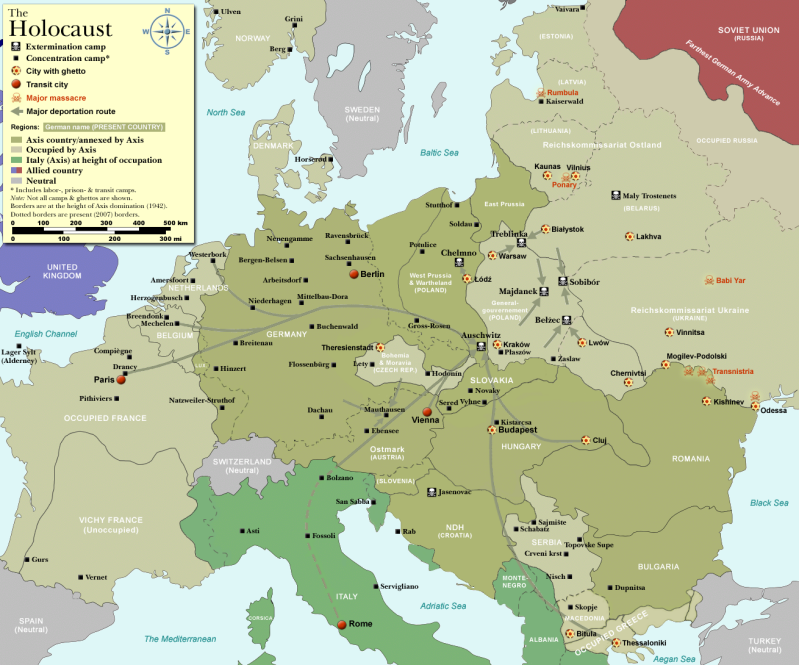
First off, let me just quickly answer the famous denier question "Why is the Holocaust emphasized so much when there have been so many other genocides in history?" Their disgusting Jew-hatred already surfaces when they insinuate it's because Jews run Hollywood and therefore have the power and money, and as "a neurotic people" have found an infinite cash cow to milk guilt-tripped 'goyim' for having allowed the Germans to put their ancestors to hard manual labor in camps for the first time since centuries.
This is a paraphrase of the most vile rhetoric holocaust deniers (in combination with their admiration of national socialism, white nationalism and "race realism" aka racism in general) usually spew, and I make no fuss about showing you their true convictions in the introductory images to give you an idea why I created this blog in the first place - it's people like this that make my blood boil, more so when they manage to corrupt innocents with their deceptive "documentaries" on sites frequented by tens of millions. Given that there was no easy-to-read counter with lots of pictures (something the public likes to see, rather than oceans of text), I got to work. So to answer why the holocaust is unique, simple:
Because it is the only 'assembly-line' style genocide in history on an industrial scale that ended up exterminating millions of people in a short period of time, most of whom belonged to one religion: The pogrom of all pogroms.
Just so that you get an approximate idea of what we're dealing with here, the image above shows the locations of most of the bigger Axis concentration and extermination camps in Europe (many of them had lots of sub-camps not detailed on the map). I do not like the distinction between these two camp types, as concentration camps exacted their own considerably high death toll from labor attrition, starvation, disease, torture, summary execution and medical experimentation, while furthermore some concentration camps like Mauthausen had functioning gas chambers as well, where thousands of people were gassed, not to mention the T-4 Euthanasia centers like Hartheim Castle and Sonnenstein Castle, or the concentration camps Sachsenhausen, Ravensbrück, Neuengamme, Stutthof and Natzweiler. On the other hand, the Janowska concentration camp (not marked on the map, but right next to Lwow), which also functioned as an extermination center had no homicidal gas chambers; mass killing at or near that camp was done by shooting. Same applies to Maly Trostenets. The claim that an extermination camp necessarily implies gas chambers or that concentration camps did not have any, is ignorant rhetoric.
However, the bulk of deliberate physical extermination en masse and mostly immediately upon arrival did take place in Poland (actually back then, in and around the area classified by the Nazis as the Generalgouvernement, as Poland had ceased to exist), and therefore those camps are labeled extermination camps, along with Jasenovac and Maly Trostenets. Note that Jasenovac was run by the NDH (Independent State of Croatia), not the WVHA (SS-Wirtschaftsverwaltungshauptamt), Odilo Globocnik (orchestrator of extermination during Aktion Reinhard), or any other German authority.
To understand the origins of the Final Solution, this makes for a good, short introduction:
https://www.youtube.com/watch?v=GPXPjZurupc
Extermination camps in Nazi occupied Poland - an overview
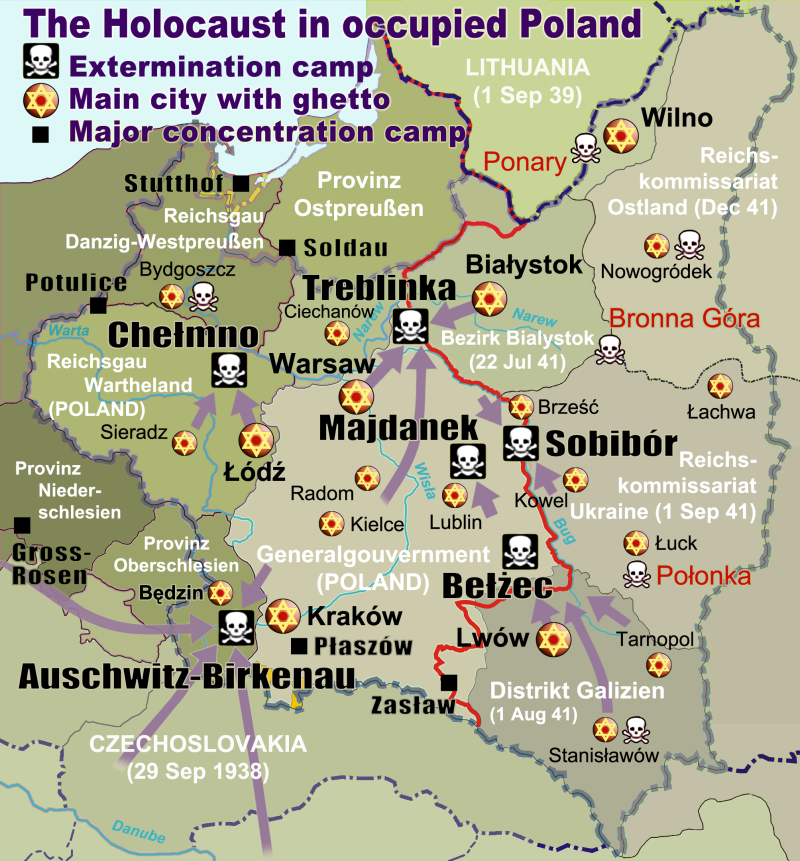
Since most of the killing took place in Poland, we'll turn our attention to this region. I will dedicate a future presentation to refute holocaust deniers regarding their claims made about Belzec, Sobibor and Chelmno/Kulmhof, but the focus of the current one will be especially about Auschwitz-Birkenau, as well as a bit about general antisemitic conspiracy theories, Einsatzgruppen, gas vans, Treblinka and Majdanek.
The reason Auschwitz-Birkenau is so infamous is because it is the camp with the highest death toll of them all. Therefore, holocaust deniers have also given this camp the most attention, in their effort to disprove the holocaust, especially the homicidal gassings of around a million people in this camp's gas chambers, and then to spin their usual yarn about the others having died due to Allied bombings destroying supply lines and infrastructure - a classic reversal of victim and perpetrator roles.

So, zooming in further, this is the layout of Auschwitz I "Stammlager" (center), Auschwitz II "Birkenau" (left), the industrial area of Monowitz used during wartime by I.G. Farben, and the Auschwitz III "Monowitz" camp located to the right.
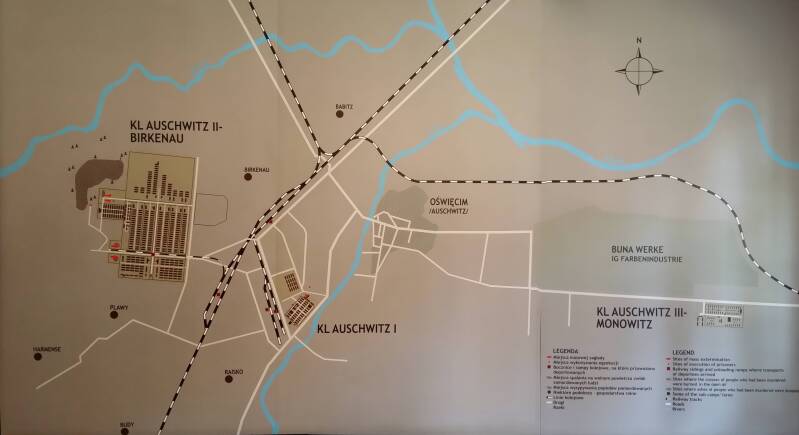
...with more detailed camp layouts.
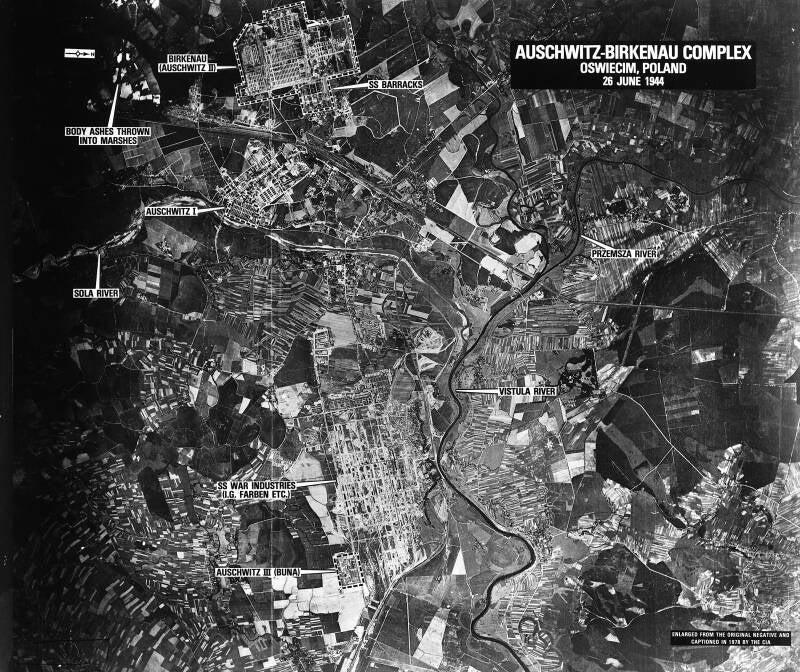
The aerial photographs that follow are part of a series of high resolution wartime photographs that were released by Dino Brugioni and Robert Poirier in 1979, as well as some taken from the NCAP archive.
Taken on June 26, 1944, you can see Birkenau toward the top of the image, the Stammlager a bit below that, the I.G. Farben "Buna-Werke" toward the bottom, and the Auschwitz III Monowitz camp toward the bottom left of the industrial area.
Please note that many high resolution aerial photographs will follow. It is best to view them in a separate tab rather than just clicking on them. This way you will be able to zoom in all the way, and won't be limited to imgur's default zoom on this page, which is limited to your monitor size and desktop resolution.
Thomas Dalton, PhD (in what?) a holocaust denier who disguises himself as "skeptic" and author of "Debating the Holocaust" makes the claim that "most damning is the June 26 photo, which, by standard accounts, should have shown us three heavily smoking crematoria and several ongoing open pit fires" (Dalton, Debating the Holocaust, p.181)
Actually, the photo should show us exactly zero smoking crematoria and zero open pit fires, since no transport had arrived the day or even the week before, which is exactly what it is doing: On 26 June 1944, no large scale killings are reported for Auschwitz-Birkenau (according to Danuta Czech's Kalendarium as well as the Glaser list). Furthermore, John C. Zimmerman, respected author of "Holocaust Denial: Demographics, Testimonies and Ideologies" has this to say:
"The best known of these photos was taken on June 26, 1944. It shows the whole Auschwitz complex which consisted of three main camps: the Birkenau camp where the gas chambers and crematoria were located, the Auschwitz main camp, and Monowitz area of the camp where industrial production occurred. The Birkenau area of the camp shows no activity. However, on this particular day there were no arrivals from Hungary."
Hungary is in so far relevant, because the majority of Birkenau extermination activity happened in 1944, a large chunk of which occurred when some 400,000 Hungarian Jews were taken to the complex during the Ungarnaktion and reduced to ash. This is also why deniers are so livid about insisting that 1944, of all years, should show damning evidence of genocide in Birkenau in aerial photography. Don't worry - there's plenty of evidence to go around, I will address these piecemeal in the aerial photos that'll follow.

A synthetic oil and rubber (Buna) manufacturing facility. Some 10,223 prisoners were stationed here shortly before liberation in January 1945

At Buchenwald, "Jedem das Seine" (literally, "to each his own", but idiomatically "everyone gets what he deserves") was used. At Auschwitz and some other camps, the logo was "Arbeit macht frei". Notice how the B in this sign is put upside down, allegedly in irony or an act of silent defiance by those who put it up. The infamous slogan reads: "Work liberates" (or "work sets you free"). Auschwitz I opened in former Polish army barracks in June 1940.
After this part of Poland was annexed by Nazi Germany, Oświęcim (Auschwitz) was located administratively in Germany, Province of Upper Silesia, Regierungsbezirk Kattowitz, Landkreis Bielitz. It was first suggested as a site for a concentration camp for Polish prisoners by SS-Oberführer Arpad Wigand, an aide to Higher SS and Police Leader for Silesia, Erich von dem Bach-Zelewski. Bach-Zelewski had been searching for a site to house prisoners in the Silesia region, as the local prisons were filled to capacity. Richard Glücks, head of the Concentration Camps Inspectorate, sent former Sachsenhausen concentration camp commandant Walter Eisfeld to inspect the site, which already held sixteen dilapidated one-story buildings that had once served as an Austrian and later Polish Army barracks and a camp for transient workers. Reichsführer-SS Heinrich Himmler, head of the Schutzstaffel (SS), approved the site in April 1940, intending to use the facility to house political prisoners. SS-Obersturmbannführer (lieutenant colonel) Rudolf Höss oversaw the development of the camp and served as the first commandant.
Auschwitz I, the original camp, was to became the administrative center for the whole complex. Local residents were evicted, and the Germans also ordered expulsions of Poles from the villages of Broszkowice, Babice, Brzezinka, Rajsko, Pławy, Harmęże, Bór, and Budy to the General Government.
The first prisoners (30 German criminal prisoners from the Sachsenhausen concentration camp) arrived in May 1940. The first mass transport to Auschwitz concentration camp, which included Catholic prisoners, suspected members of the resistance, and 20 Jews, arrived from the prison in Tarnów, Poland, on June 14, 1940.
The inmate population grew quickly as the camp absorbed Poland's intelligentsia and dissidents, including the Polish underground resistance. By March 1941, 10,900 were imprisoned there, most of them Poles. By the end of 1940, the SS had confiscated land in the surrounding area to create a 40-square-kilometer (15 sq mi) "zone of interest" surrounded by a double ring of electrified barbed wire fences and watchtowers.
Do you want me to let you in on a little "secret"? The infamous Arbeit Macht Frei sign so significant to Auschwitz and shown to over a million tourists each year is, in fact, a post-war fake. And do you want to know why it is fake? The story is tragic: Because the original was stolen by thieves. Motivation for the theft was originally thought to be for financial gain, however when the individuals responsible for the theft were identified it was revealed that the thieves themselves were affiliated with the Neo-Nazi movement. This fact is also told to tourists before they enter the camp, and therefore it's not really a secret.
The sign over Auschwitz was stolen in December 2009 and (thankfully) later recovered by authorities, but in three pieces. Anders Högström, a Swedish neo-Nazi leader, and two Poles were jailed as a result. The original sign is now in storage at the Auschwitz-Birkenau State Museum and a replica was put over the gate in its place.
Arbeit macht Frei signs also exist in other camps, like Dachau, Sachsenhausen, Flossenbürg, and Theresienstadt. In November 2014, the sign over the Dachau gate was also stolen. The thieves remain unidentified as of 2016 and the artifact has not been recovered.
This is part of the motivation of why I did this blog - to expose people attacking the holocaust not for what they claim to be, i.e. honest scholars trying to correct an erroneous historical record, but for what they really are: rabid Neo Nazis using various methods to conceal and better present their Jew hatred.
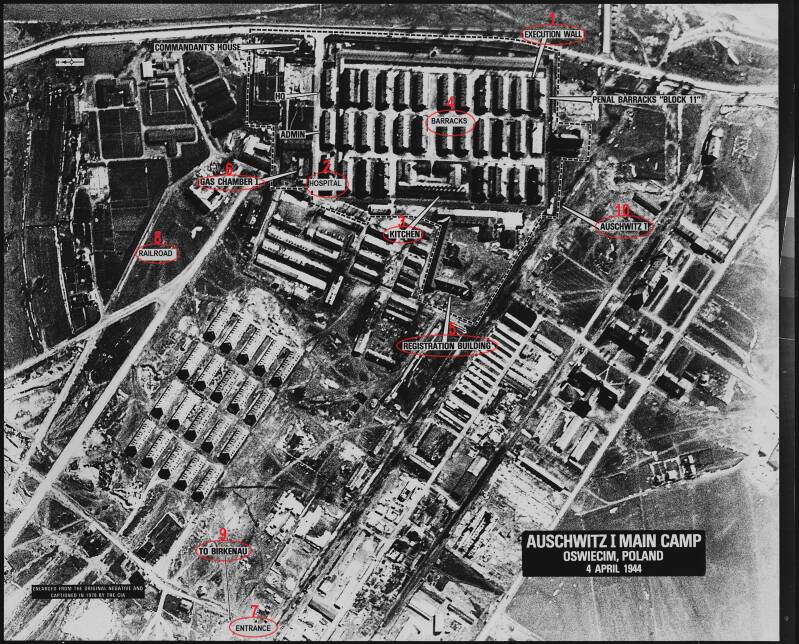
This is an aerial shot of Auschwitz I Stammlager, taken on April 4, 1944
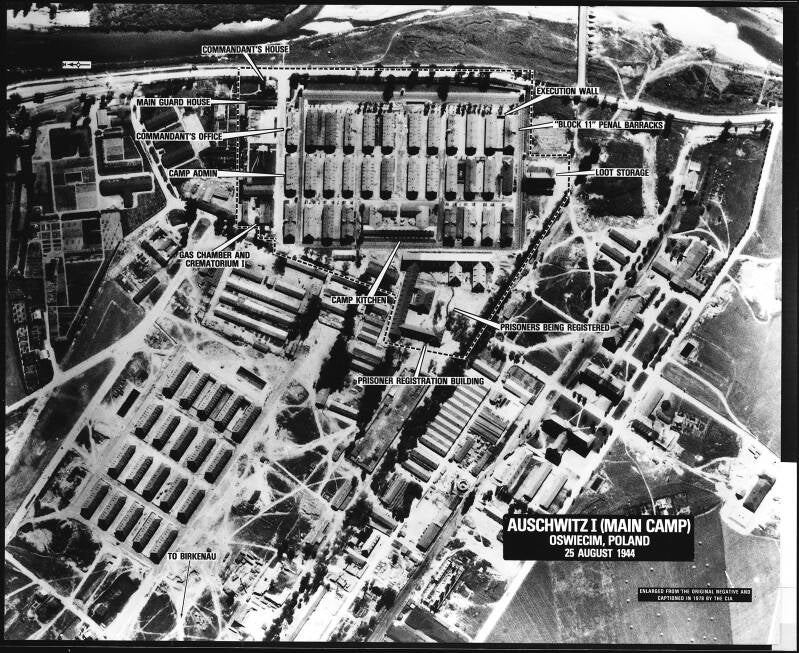
Taken more than 4 months later
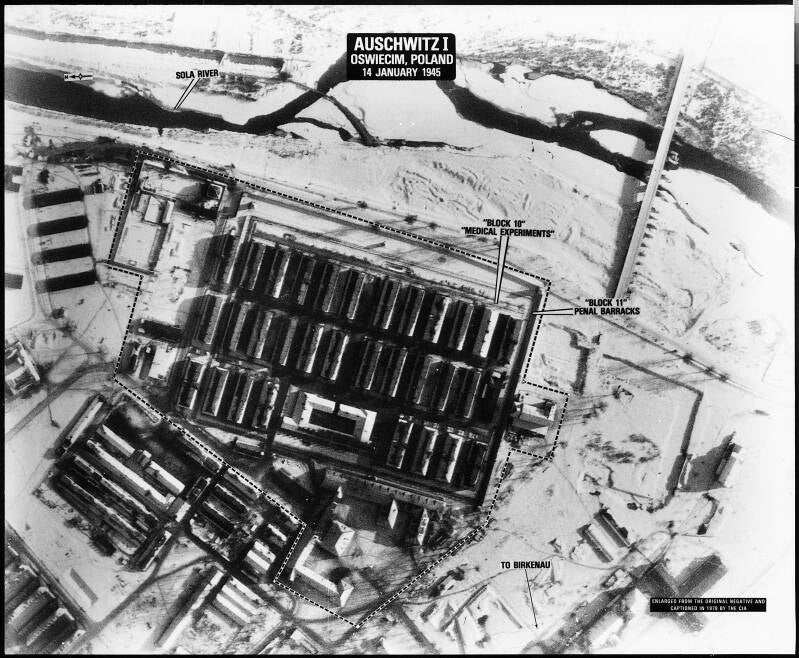
Another aerial shot, taken almost another 5 months later, on January 14, 1945, about two weeks before the camp's liberation on January 27th, International Holocaust Remembrance Day. Snow melt on the roofs indicates that the barracks remain occupied, with one important exception. The lack of heat and presence of snow on the roof of Barracks Block 10, site of infamous medical experiments, indicate that it is empty.
Denier infographic # 1: A fat Jew means he did not starve

This picture is often brought up when one tries to debate a denier on undernourishment and starvation running rampant in German concentration camps. When the denier is not busy:
1) spinning the tall tale of Allied bombs destroying German infrastructure and therefore being the main cause of emaciated corpses found by the Allies by the end of the war upon the camps' liberation
2) or saying those corpses are all typhus victims
3) or saying those corpses are German victims collected from the cities, carried over to the liberated camps by "Allied psych warfare divisions", stripped naked and photographed
...he will show you pic related instead, as an example of just how good those Jews had it in the camps.
Except....this picture isn't even from World War 2. You heard right. The picture was taken by SS and Himmler's personal photographer Friedrich Franz Bauer on the 20th of July 1938, is stored in the German Federal Archives (Sammlung Berlin Document Center, Bild 152) and shows detainees of Dachau concentration camp, which had been operational for YEARS before WW2 started, standing for an Appell, a mustering.
Even earlier, on July 16, 1933 Bauer wrote and published a propaganda photo report about the Dachau concentration camp in the journal Munich Illustrated Press. It was under the title "Die Wahrheit über Dachau" (The Truth about Dachau). This report was intended to refute criticism of treatment of prisoners at the concentration camp by showing photos of prisoners' appearances to be "normal" and "well dressed". Looks like Bauer's techniques keep working some 80 years later...
Needless to say, we do not know how long it had been since this inmate was transferred to the camp. Heavy people don't turn into emaciated Muselmänner from one day to another, or even one week to another. Therefore the act of using this picture of a fat Jew as proof that he was receiving adequate food in the camp, is the epitome of stupidity.
see:
The Auschwitz death book gambit
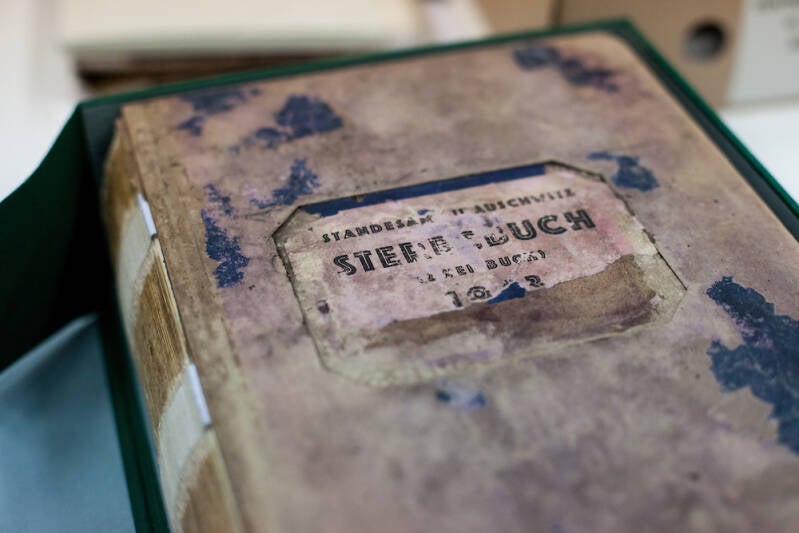
Pic related shows a camp death book (Sterbebuch) at the Auschwitz Museum Preservation lab for documents, books and other historical papers. All together 51 death books were so far preserved, in which the camp Political Department (Politische Abteilung), in other words, the Gestapo, recorded the deaths of 69,000 registered camp prisoners who died between July 29, 1941, and December 31, 1943.
Holocaust deniers claim:
"Auschwitz-Birkenau was not a center of extermination for the Jews of Poland and Europe. Collections of camp death certifications (Death Books) list only 69,000 deaths in the entire inmate population—all from natural causes."
However, the reality is that the Auschwitz-Birkenau Death Books do not reflect the nearly 900,000 Jews who were murdered in the gas chambers upon arrival at the camp. Only those prisoners who were inducted into the slave labor pool (including some 230,000 Jews) were given numbers and only those prisoners were listed in the death certificates in the Death Books. The death certificates certified that these prisoners died of "typhus", the “weakness of old age,” “influenza,” “heart failure,” “pneumonia,” etc.
According to Holocaust deniers, these books of death certificates “discredit a central pillar of the Holocaust extermination story—that is, that Jews were murdered en masse by poison gas."[1]
The death certificates record the date of issue, first and last names, date, time and place of death, date and place of birth, and cause of death. The cause of death was usually fictitious. In January 1945, when the Russians liberated Auschwitz-Birkenau they took the Death Books back with them to Moscow where their existence was unknown until they were released in 1989 for use by researchers. In 1991 they were repatriated to the Auschwitz-Birkenau State Museum.
How we know that some 900,000 Jews were murdered in the gas chambers without their number being listed in German records? Rudolf Höss was the commandant of Auschwitz-Birkenau from mid-1941 to December 1943, after which he was promoted to the administrative office that supervised all of the camps. In early May 1944, Höss briefly returned to Auschwitz-Birkenau to take up his command again during the Hungarian Action. After the war, Höss was arrested, tried, convicted and put to death for his role in the Final Solution. Before he was executed he wrote his memoirs in which he noted: “Originally, all the Jews transported [to Auschwitz-Birkenau] . . . were to be destroyed without exception, according to Himmler’s orders.”
However, because of labor needs in the armaments industry by 1942 some able-bodied Jews were saved as workers. According to Höss: “The railway cars were unloaded one after another. After depositing their baggage, the Jews had to individually pass in front of an SS doctor, who decided on their physical fitness as they marched past him. Those who were considered able-bodied were immediately escorted into the camp in small groups. Jews selected for gassing were taken as quietly as possible to the crematories.” Only those selected for labor were given numbers, the Jews sent to the gas chambers were not.
These prisoners who passed the Selektion were the ones accounted for in the Death Books. Like the inventory for a business, these prisoners were now the property of the Third Reich. Stanislaw Jankowski was a member of the Sonderkommando at Krema/Gas Chamber V in Birkenau. Jankowski gave a deposition to the Russian authorities after the war: “I have to stress here that only persons destined to do various kinds of work were included in the registers of prisoners’ strength and were given camp numbers. No camp numbers were given and no registration was effected . . . in the cases of all those who went straight on to the gas from the transports . . .”
Jankowski further noted: “Circa 30% of the then arriving transports . . . were selected to be put in the camp . . . The rest were gassed and cremated in the crematoria ovens.”[2]
Franciszek Piper, a Polish scholar and historian, conducted extensive research on the total number of people that were sent to Auschwitz-Birkenau from all over Europe from 1940 to 1945. Piper concluded that the total number of people who were sent to Auschwitz-Birkenau was at least 1,305,000. This figure included Jews, Gypsies, Soviet prisoners-of-war and non-Jewish prisoners of other nationalities. Inside this figure the total number of Jews sent to Auschwitz-Birkenau was about 1,095,000, of which at least 865,000 were murdered immediately. The remaining Jews—some 230,000—were admitted to the camp as slave laborers.[3] Of those people admitted as slave laborers, some 188,000 were transferred to other camps and so were not directly murdered in Auschwitz-Birkenau. Among these were Anne Frank and her sister, Margot, who died in the Bergen-Belsen concentration camp and Elie Wiesel who was liberated in Buchenwald concentration camp in Germany.
Piper was able to trace the fate of the Jewish transports that arrived in Auschwitz-Birkenau. For instance, on August 10, 1943, a transport of about 3,000 Polish Jews from Sosnowitz, Poland: “Following the selection, 100 men, given Nos. 136303-136412 and 195 women, given Nos. 54332-54526, are admitted to the camp. The other almost 2,700 people are killed in the gas chambers.”[4]
Conclusion:
The Holocaust deniers’ assertion that the Death Books reflect the total number of deaths in Auschwitz-Birkenau is false. The Death Books do not reflect the nearly 900,000 Jews who were murdered upon arrival at Auschwitz-Birkenau. Sometimes these people were not even properly counted, much less registered or phony death certificates created. Only those people who were inducted into the slave labor pool (including some 230,000 Jews) were given numbers and only these prisoners were listed in the death certificates in the Death Books.
Sources:
[1] Mark Weber, “Pages from the Auschwitz Death Registry Volumes: Long-Hidden Death Certificates Discredit Extermination Claims,” Journal of Historical Review, Fall 1992, (Vol. 12, No. 3).
[2] Robert Jan van Pelt, The Van Pelt Report (“IV Attestations, 1945-46”).
[3] Franciszek Piper, Auschwitz: How Many Perished Jews, Poles, Gypsies . . . (Krakow, 1994), pp. 51-57. [4] Danuta Czech, Auschwitz Chronicle 1939-1945 (Henry Holt, 1997), p. 459.
"The Aktion" at Block 11 - one of the first gassings
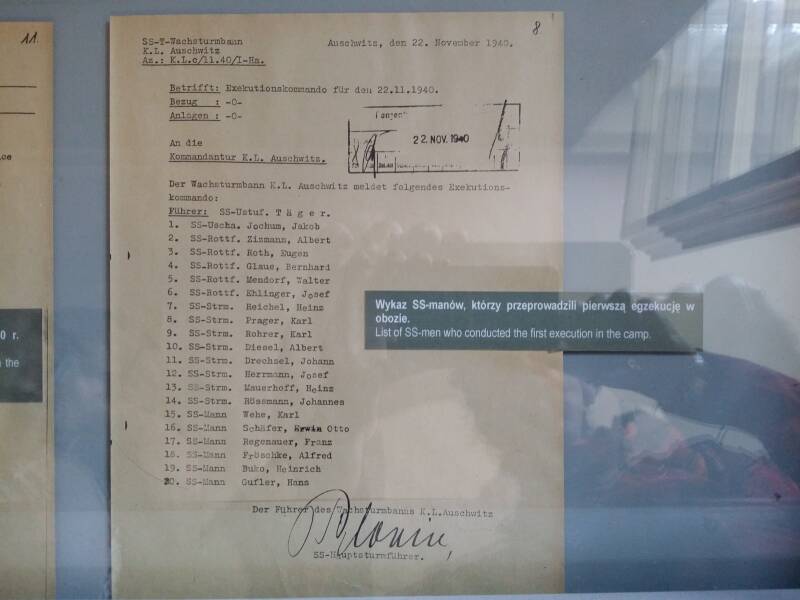
Document listing the names of an Auschwitz execution squad, November 22, 1940
Oh I'm sure deniers will start rambling on about the fact that the word "execution" could mean a ton of various things, for example the execution of some harmless work-duty...
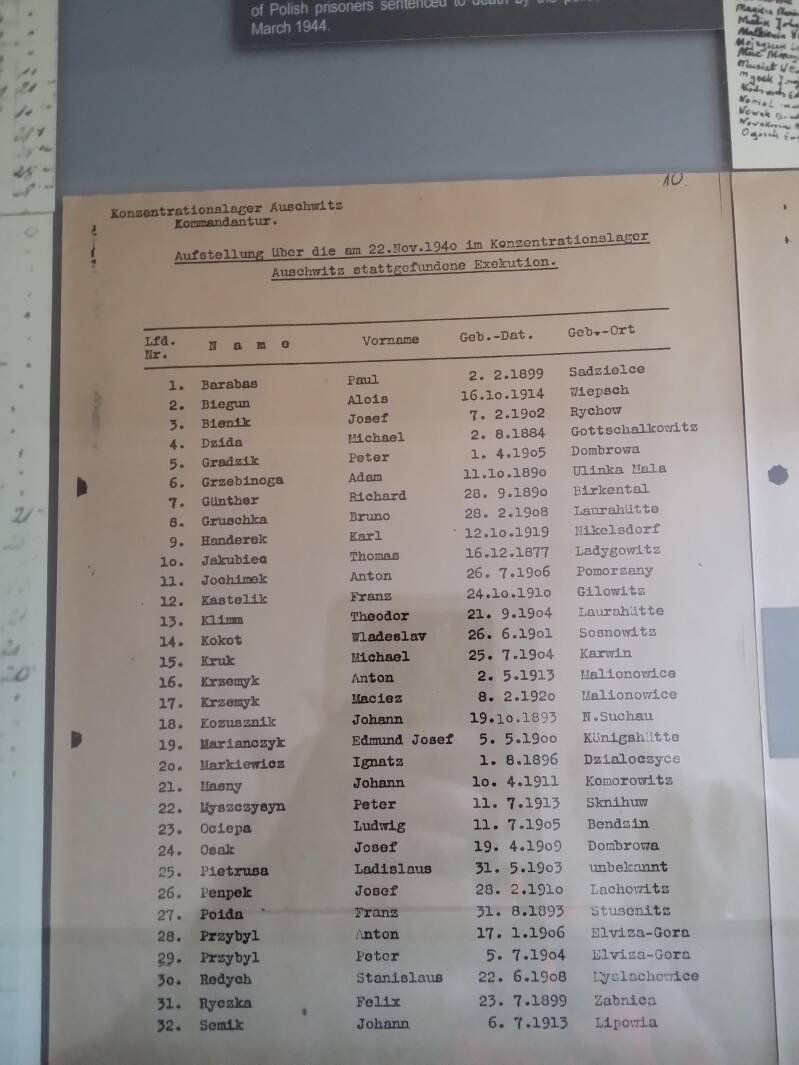
Document listing the names of those executed, November 22, 1940
...except we also have the document listing the names of that same event's victims. Oh I'm sure the execution of some harmless work duty would warrant such a list to be created, including the last and first names of those involved, as well as their birth date and birthplace...
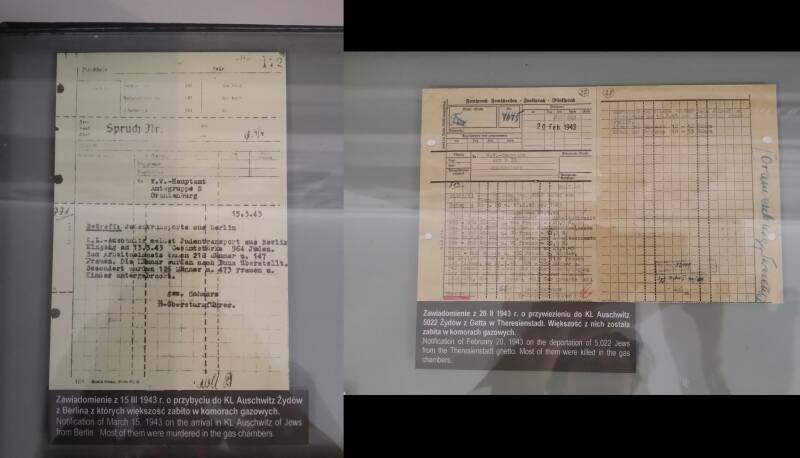
"Gesondert untergebracht" is code-word for homicidal gassing
These are just two documentary examples of the Selektion process, i.e. Jews getting off a train and then being divided into men and women, and further divided into those fit for labor (e.g. being sent to the Buna-Werke in Auschwitz III Monowitz), and those who weren't selected for labor. What do you think happened to those who weren't selected for work duty (Arbeitseinsatz)? Did they get to sit around all day in the camp twiddling their thumbs? As the documents state, they were "gesondert untergebracht", which translates to "accomodated separately" or received "special accommodation".
Deniers assume that means what it says on the paper. Which would insinuate there were not only women with children in Auschwitz, but even men who were not selected for work duty. Take a look at the document on the right. We have thousands of Jews being brought in from the Theresienstadt ghetto in early 1943. Of these, only some 15-20% are being selected for work. Everyone else gets special accommodation? Because, as the last sentence in the document explains, the men were infirm and there were so many children in the women's group?
I sure would like the deniers to show me where these "special accomodations" were in Auschwitz, reserved for women, children and elderly. I know where they were and what they were called: Krematoria I, II, III, IV, V and the red and white house.
The hair room
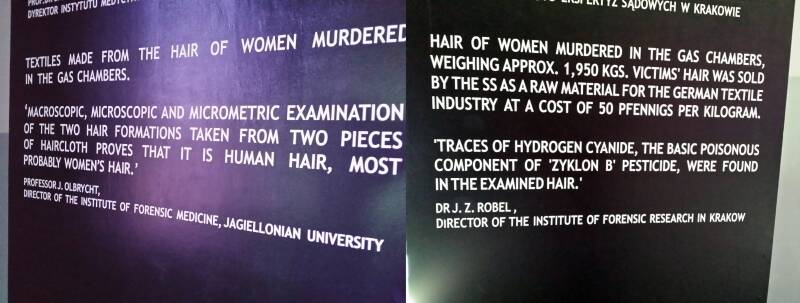
The only place in Auschwitz today where photography is prohibited is in the museum's room containing some 2000 kilograms of shorn hair, due to Jewish rites concerning the dead. However, I did manage to snap the inscriptions on two signs there, which conclude that forensic testing not only revealed the hair to be human in origin, but also that it contained traces of hydrogen cyanide.
Which corroborates testimonies of gassing victims in Auschwitz being shorn AFTER they were gassed, rather than before.
On a similar note, there goes revisionist veteran and "esteemed" professor Robert Faurisson's ridiculous theory of corpses "saturated with hydrogen cyanide" killing anyone who handled them. The man should stick to teaching literature instead of trying to pass for a scientist.
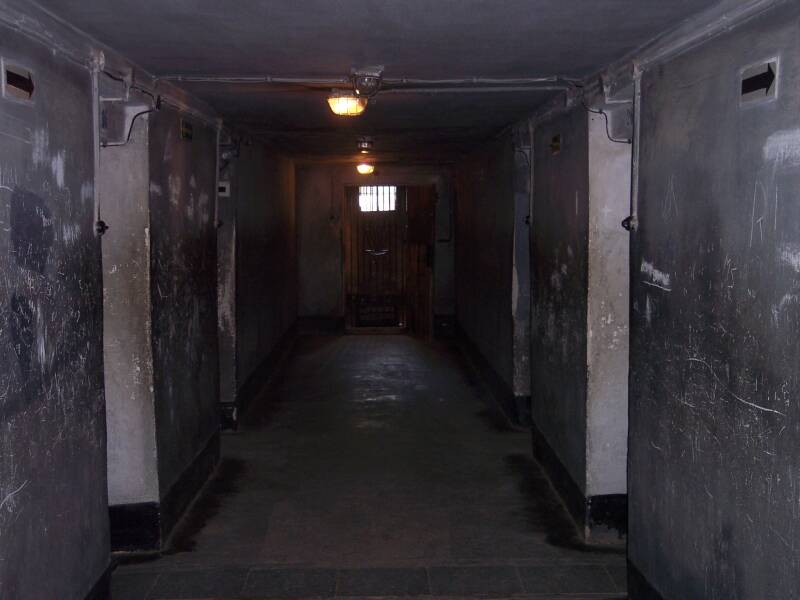
Holocaust deniers often make the passive-aggressive claim: “Show me one name, one single name, with proof that a person was gassed at Auschwitz”, thinking historians are unable to answer this basic question. How about two names? Fritz Renner and Bruno Grosmann, both from Breslau, and both prisoners died on September 5, 1941, by gassing in the basement of Block 11 (at that time, Block 13).
One day in the autumn of 1941, something happened in the Auschwitz Stammlager that was unprecedented and so extraordinary that it made a deep and lasting impression on all who witnessed it. The Aktion took place in the middle of the camp and lasted for several days, from the first preparations until the final clean-up. Several dozens of prisoners were involved in it as participants, and hundreds saw, at least partially observed, what was going on.
It is recorded in the work of former Auschwitz political prisoner Stanisław Kłodziński, presented in the scholarly journal Przegłąd Lekarski, no. 1/1972, under the title Pierwsze zagazowanie więźniów i jeńców w obozie oświęcimskim on pages 80-94. In 1969, he wrote to 250 former Polish prisoners across Poland, who in the autumn of 1941 had been in Auschwitz, and who could have been witnesses or participants of the Aktion, and asked them about it. He received 108 positive responses. They tallied to a degree of 90% with regard to basic information, from which we can compile the following approximate time-line:
1st day: All the bunks from Block 11 are carried to the garret. The prisoners who are billeted in Block 11, i.e. the “quarantine” and penal companies, and all inmates of the Bunker cells (the whole basement of Block 11) are transferred to another block. Material for sealing doors and windows inside the bunker and soil for filling up the windows from outside is brought to Block 11.
2nd day: The doors of the cells are sealed, also the windows from inside. A prisoner work detail fills up the windows of the basement of Block 11 (outside) with soil. The plumber work detail checks the function of the central heating in the Bunker. In the camp hospital, pre-selections are carried out among the sick.
3rd day: Beginning in the morning, SS doctors select a rather large group of sick prisoners from the hospital blocks. Immediately after the evening roll call, Lagersperre is ordered. Exempt from it is a work detail of prisoner orderlies, who carry and lead the selected sick comrades to Block 11 and cram them into a part of the Bunker cells. Shortly thereafter, several hundred Soviet POWs, who arrived by trucks, are herded into the remaining cells. Then one or more SS officers with gas masks enter Block 11.
4th day: In the night, the prisoners in the adjacent blocks hear terrible cries from the Bunker. In the morning, an SS officer with a gas mask enters Block 11 again for a short time. The camp commandant orders that the premises be aired out for two days. Again Lagersperre is ordered after evening roll call. Exempt is a prisoner work detail that begins to remove the soil from the Bunker windows. The windows and the doors of the bunker are opened for airing.
5th day: During Lagersperre, ordered again after evening roll call, a working squad is formed from about a dozen prisoner orderlies. They and the “corpse carrier” working squad (Kommando Leichenträger) are summoned to Block 11. They enter the Bunker and find all prisoners there dead. They pull out the corpses from the cells, undress them, and carry them away for burning or burial. The complicated labyrinth of corridors and cells in the Bunker makes the work last until early in the morning.
6th day: A cleaning squad, probably from the penal company, removes the remnants of the sealing and cleans walls and floors. The state of Block 11 is restored as it was before the Aktion. Its inmates return to their rooms. The Bunker is ready for new intakes.
I deliberately left out from this time-line everything the prisoners could not have witnessed personally, e.g. what the SS men with gas masks did in the basement of Block 11. It is also obvious that not every witness could have witnessed the whole Aktion. But from the set of information, by clustering and eliminating testimony that is off and by combining the parts of the puzzle, every honest and professionally working historian would have derived a similar picture of the Aktion.
As I previously said, the prisoners could not see what the SS men did in the Bunker late in the evening of the 3rd day and on the 4th day in the morning. They could see, however, that the SS men who entered the building wore gas masks, they could witness that the Bunker was aired for quite a period of time, during which nobody entered the building, and they saw, on the 5th day, that all those were dead who had been alive in the Bunker still in the evening of the 3rd day. They also knew that, on the 2nd day of the Aktion, doors and windows were sealed. It does not take much imagination to conclude from this that the prisoners in the Bunker had died from poisoning by some gas that was introduced by the SS on the evening of the 3rd day.
Though there cannot be the slightest doubt that the Aktion took place, there remains the question of when it took place. The great majority of witness testimonies set the Aktion in the month of September 1941. Here a “hard” document is helpful: the Bunker ledger (Bunkerbuch), which was smuggled out by the camp resistance and survived the war, shows only one “window” into which the previously established time-line fits: September 3rd to 8th. This means that the gassing (3rd day) took place on September 5, 1941, in accordance with the early reports from the Polish camp resistance.
It is first mentioned in the Situation report for 15.VIII – 15.XI.1941 of the Polish Government-in-Exile’s Home delegation, a contemporary source: “The camp was the scene of a perfidious crime when, on the night of September 5, about 600 Soviet prisoners including army political indoctrination officers and about 200 Poles were crowded into a ‘bunker.’ After the ‘bunker’ was sealed, they were poisoned with gas and their bodies taken to the crematorium and burned.”
There remains, however, a remarkable fact: the Bunker ledger mentions for September 5, 1941, not only the intake, but also the death of three prisoners: two Germans and a Pole, as well as the death of a Polish civilian, who had been taken in before September 5. This is a confirmation of the Aktion, since we here have the documented fact that all those who were registered in the Bunker ledger and who were in the Bunker on that day - the aforementioned three concentration camp prisoners and the Polish civilian - suddenly died on one and the same day. Moreover, the date of September 5 is again confirmed, because the killing in the Bunker could not have started earlier than the admission of the three prisoners on that day. If the Aktion in which they died was the “first” gassing or a later one, is of little importance. At any rate, it was the first that drew the attention of nearly the whole camp on itself.
Theoretically, the four could have been taken out before the sick prisoners and the Soviet POWs were crowded into the Bunker, and could have been shot at the Wall of Death, as was the routine procedure for Bunker inmates condemned to death. But here enters the Rögner report, which states that two German prisoners were not taken out in the course of the Aktion and died together with the others. Sure, Rögner is not the most precise witness, and he does neither give the names of the prisoners nor an exact date of the Aktion. As Kapo of the electricians’ work detail Rögner got around all over the camp, and as a German he observed and remembered many things concerning German prisoners, in which the Polish majority was not much interested. That two German prisoners were in the Bunker during the Aktion was something extraordinary, worth remembering for a German Kapo. And who else could they have been than Renner and Grosmann, registered in the Bunker ledger on that very day?
- by Dr. phil. Joachim Neander, Kraków, Poland
Krema I, located at Auschwitz I main camp

Krematorium I is the only intact crematorium + gas chamber building in the entire Auschwitz-Birkenau complex today. All other Krema buildings are either ruins or have been razed to their foundations by the Nazis before they retreated in January 1945 due to the advance of the Soviet Red Army - except for Krema IV, which had been badly damaged during the Sonderkommando Uprising back on October 7th, 1944 already[1].
So the first question we must ask is: If these were just harmless delousing facilities or morgues, as the deniers maintain, then why did the Nazis take the extra trouble to blow up these installations before retreating, while leaving almost all of the other buildings intact? Something tells me they were trying to cover up their crimes against humanity. A few deniers like to challenge this observation by claiming that it wasn't the Nazis, but the Soviets that blew up the Kremas (without offering any proofs, as usual). However, we know it wasn't the Soviets that dismantled Kremas II, III, and V because this process can already be observed via the aerial photos taken in December 1944 (https://imgur.com/NiCqlpx) and mid-January 1945 (https://imgur.com/ov5vCuU), BEFORE Auschwitz was liberated by the Red Army on January 27th, 1945 (International Holocaust Remembrance Day).
The sign outside Krema I
Returning to the first sentence of the paragraph above, we can visit Krema I today, but this building is a 1947 reconstruction. There is a sign outside (imgur.com/duS3xZA) telling visitors about the history of the building. Note the Zyklon-B inlet holes in the roof. I address these here: (imgur.com/q4VFa66). But first, let's look at the big smokestack.
More than two decades ago, a young, and completely-ignorant-of-structural-engineering David Cole, and later, a certain Dr. Frederick Töben, were highlighting the fact that the chimney isn't attached to the former crematorium, and is therefore completely useless, a "post-war fake". If they had taken some lessons from structural engineers, they would have known that the flues which connect the chimney to the ovens were underground (https://i.imgur.com/aitbmff.jpg).
Furthermore, we have air-photo evidence proving the existence of the chimney - a few meters away, and therefore seemingly detached from Krema I at ground level - even during the war: imgur.com/NF1BtZf Here is a cinematic clip taken from a German holocaust documentary that recreates the scene of people being led into Krema I in the Auschwitz I Stammlager for gassing. It demonstrates how the SS-guards poured the Zyklon-B from the holes in the roof into the chamber below: https://www.youtube.com/watch?v=hBc3y8A7DmY
Source:
Holes on Krema I's roof, and their correspondence to the building's interior

To summarize, Krema I was originally a munitions bunker, and used from August 1940 to July 1943 as a crematorium with 3 double-muffle ovens. Autumn 1941 onward, it was also used as a gas chamber. Summer 1942 onward, the gassings gradually moved from the Stammlager over to Birkenau, when more and more gas chambers were constructed there. By July 1943 the cremation had also stopped here. The building was then used for storage, and eventually as an air-raid shelter (toilets were installed, and the gas chamber was subdivided with additional wall segments for the additional structural stability needed to better support the ceiling) for the SS HQ stationed in the offices nearby as the war turned sour and the industrial area of Auschwitz III "Monowitz" was subjected to bombing raids by Allied forces. This also explains the wooden doors nobody (except deniers) claim is the original gas chamber door (more later).
photo credit: BroI (Jan 2012)
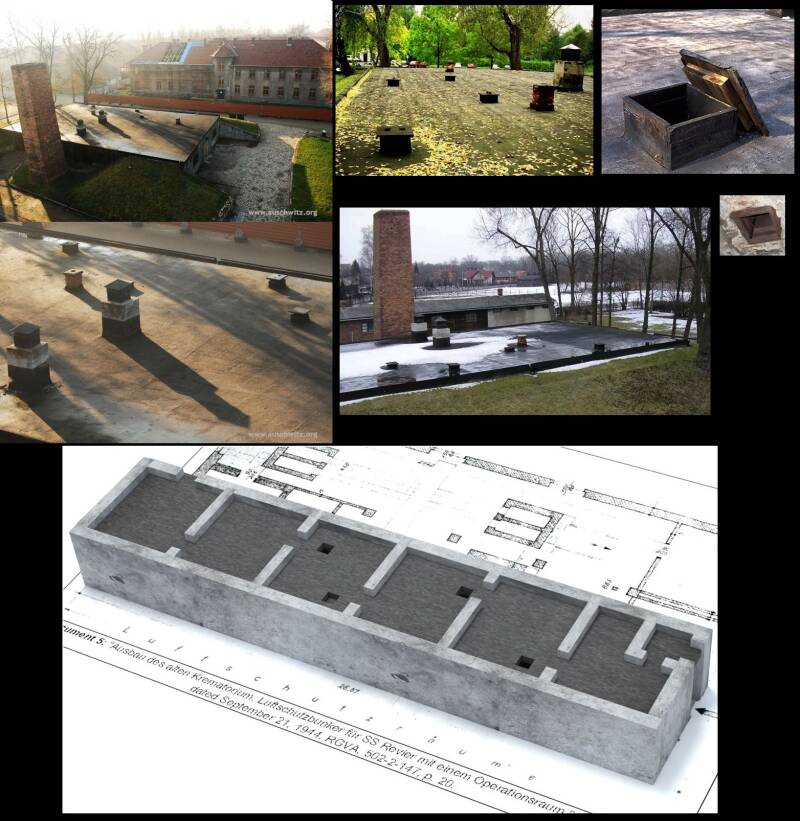
Let's look at the bottom part of the above image first. What we see here, is Eric Hunt's 3D model of roughly half of Krema I. It covers (from left to right) the "storage for spare gratings" room, the wash room, the gas chamber, and the vestibule.
When Krema I was partially reconstructed in 1947, 4 interior walls were knocked down (2nd, 3rd, 4th and 5th from left to right). The Soviets made two mistakes: one, knocking down the 2nd wall, as this was the actual gas chamber wall rather than the 1st (which is the wall between the store room and the wash room where a wooden door is located). And the second "oddity" (I wouldn't say mistake) they made is leave the vestibule to the right intact, as this is not on the 1942 blueprint and was part of the efforts (along with the 3rd, 4th and 5th interior wall that are also missing on the blueprint) of the Nazis to convert the building into an air-raid shelter with the additional walls reinforcing structural integrity.
Holocaust deniers say, that if you leave the first two walls (from left to right) intact and remove the 3rd, 4th and 5th wall as well as the vestibule to get the original gas chamber configuration, you end up with holes in the ceiling that are not spaced out properly (they are if you knock down the 2nd wall and consider the 1st wall as the gas chamber wall, i.e. the way the interior looks today, but which is false). They tout this as proof that these holes were not placed there by the Germans and instead are a Soviet invention, with the Soviets' dumb mistake of knocking down one wall too many interior walls leading to them spacing out the holes wrongly, and therefore getting caught by our revisionist heroes some decades later.
This conclusion deniers make would indeed have made sense IF one of the holes today were to be found OUTSIDE the borders of the morgue that ended up being the gas chamber - except that isn't the case. What we have instead, are all four holes located exactly on the morgue roof, except they aren't as symmetrically spaced as people suffering from Obsessive-compulsive Disorder would like them to have been.
Now while I personally am leaning toward a 3-hole configuration having been the historical case, the 4-hole configuration is still anything but far-fetched. Let me explain: this asymmetry makes sense, given that the Krema I gas chamber is the only gas chamber in the entire Auschwitz-Birkenau camp complex to have had two gas chamber doors in close proximity to each other: placing an additional zyklon hole close to the two doors would ensure higher initial levels of HCN lethality near said doors to prevent the trapped from trying to break these open.
I do not try to exculpate the Soviets from their shoddy reconstruction work, however. Because knocking down the original gas chamber wall while leaving the vestibule intact, and making a wrong entrance to the crematorium that does not align with the tracks anymore is shoddy restoration work indeed. Now let's take a look at the roof. There's a whole bunch of stuff here, so bear with me. We have two smaller chimneys above the crematorium section of the building. And of course the 4 zyklon-b inlet holes poking through the roof and protected from the elements by square-shaped wooden covers (for a closeup, see top right). We also have two smaller chimneys in between (3rd row of chimneys going away from us from left, in the centre top of the above image).
The Nazis sealed up the vents when they converted the building to the air-raid shelter, and the smoothness of the roof indicates the Soviets didn't miss these and drill in the wrong place. The only question then, is if the Soviets drilled too many holes, as eyewitness accounts indeed vary regarding the exact number of zyklon-b vents on the roof of Krema I. There definitely were two, three is a reasonable estimate, though four is a bit less likely. Given that the gas chamber of Krema I is much smaller than that of e.g. Krema II or III in Birkenau (and those used to have 4 inlet holes each, as I will show air photos indicating this later on), I do agree that 4 holes on Krema I's roof seems a bit much.
This is really the best holocaust deniers have so far been able to legitimately achieve: make historians ask themselves whether the Soviets drilled one too many holes during restoration or not. For more, see:
http://holocaustcontroversies.blogspot.co.at/2016/02/on-number-of-zyklon-b-introduction.html
Wartime aerial photographs of Krema I compared with modern satellite imagery
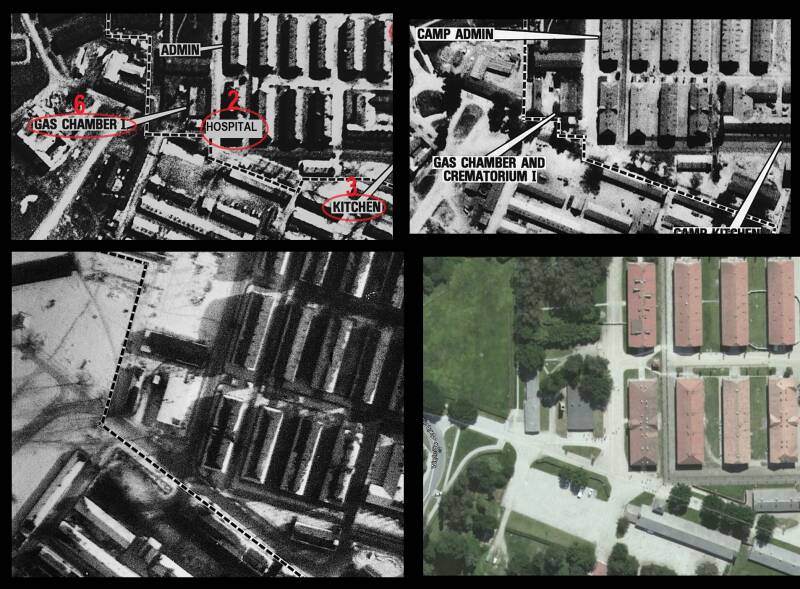
What I have done here, is compare wartime aerial photography of Krema I with that of a modern satellite image provided by Google Earth. In clockwise order from top left to bottom left, we have the images taken on April 4th 1944, August 25th 1944, modern satellite image, and January 14th 1945.
In the bottom left part of the image above, you can see the new tunnel-like entrance created after Krema I's transformation to an air-raid shelter - an entrance that is not visible in earlier photographs.
Some more observations:
- the chimney today is not in the same position as the chimney was in the wartime photographs
- the two smaller chimneys above the crematorium's roof section are visible in both wartime photography and today's satellite imagery
- despite us knowing that zyklon-b holes exist on today's Krema I roof, these are baaaarely visible in the satellite photo
- there definitely are some objects visible on the gas chamber's roof section of Krema I in the April and August 1944 photos that are no longer there in the January 1945 photo. Keep in mind though, that we have no idea how thick the snow on the roof in the January photo really is.
These observations lead me to believe Krema I was not fully converted into an air raid shelter until at least September 1944.
Krema I blueprint and underground chimney flues
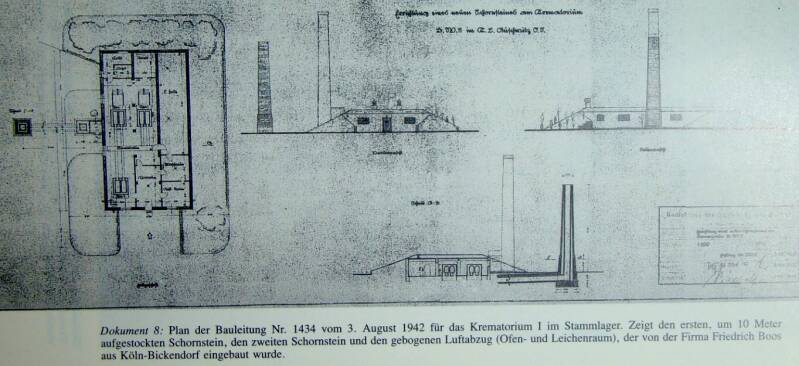
Regarding many holocaust deniers' observation that the chimney is not connected to Krema I, the blueprints demonstrate the underground flues leading to the chimney, located apart from the building. In fact, Krema I has a history of multiple chimneys:
15.08.1940 - First chimney 10 metres tall completed (Chimney 1) and first cremation performed in the sole double-muffle oven
20.02.1941 - Second double muffle oven is completed
??.04.1941 - Chimney height is increased to 20 metres (Chimney 2) to raise the performance of second oven by increasing the draft
23.06.1941 - Constant use results in the chimney cracking; cremations cease for 5 days whilst iron bands are put on the chimney
30.05.1942 - Installation of third double muffle oven finally completed
30.05.1942 - Once all three ovens are fired up, the iron hoops on the chimney snap and deep cracks appear in the masonry. "The men of the Political Department began to fear that the smokestack would collapse on to their offices."
12.06.1942 - Construction of a new chimney 15 metres tall begins
08.08.1942 - New chimney is complete (Chimney 3), cremations resume after 3 month gap during which a typhus epidemic raged
13.08.1942 - New chimney is damaged by the three triple muffle ovens constantly working at full capacity
??.07.1943 - Cremations cease at Krema I
??.10.1944 - (date approximated) Chimney (3) is demolished as part of the process of converting the building to an air raid shelter
1946-1947 - Soviets reconstruct the chimney we see today.
Krema I ovens
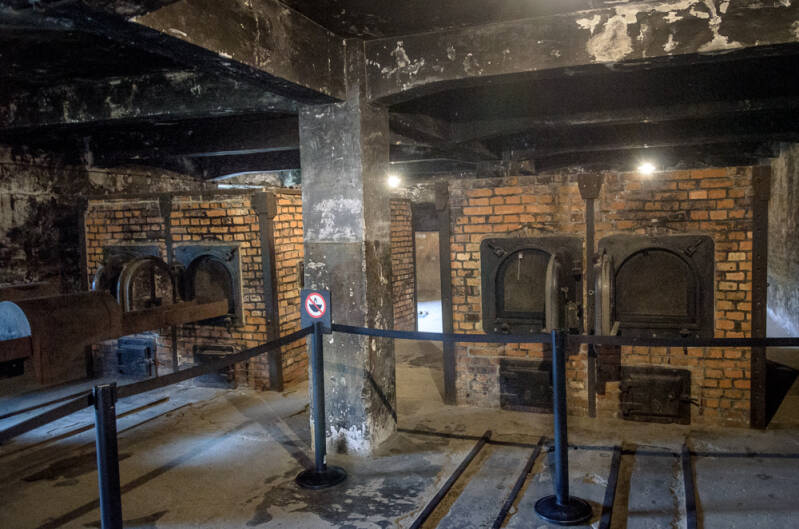
Pictured are two of the three double-muffle Topf & Sons ovens in Krema I. The small doors at the bottom are for the removal of the ashes. There are doors on the rear as well, meant for the coke.
Krema I gas chamber
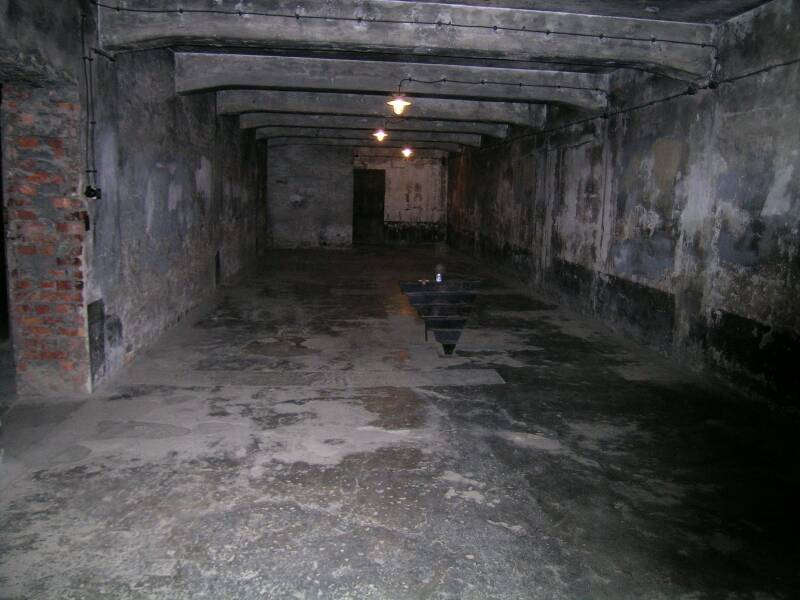
Note the wooden door at the far end, one of two, which I will address later The operation of the gas chamber from openings in the roof was described by the SS men Rudolf Höß, Hans Aumeier, Maximilian Grabner, Pery Broad, Hans Stark, Richard Böck, Martin Wilks and the prisoners Ignacy Golik, Hermann Langbein, Karl Lill, Zdzislaw Mikolajski, Edward Pys, Jan Sikorski, Czeslaw Sulkowski and Stanislaw Jankowski
(from Brian Harmon's TECHNICAL ASPECTS OF THE HOLOCAUST: Cyanide, Zyklon-B, and Mass Murder)
Many documents discussing the operation of the gas chambers at Auschwitz exist, but first we'll go through some testimonies. The testimony of Hanz Stark is an excellent example. Hanz Stark was connected with Auschwitz's "Political Department", and was responsible for registering new arrivals to the camp. He was also responsible for observing executions carried out in a room next to the crematorium, initially carried out with a small caliber rifle. The terminology used for people dispatched in this manner was "Sonderbehandlung" -- special treatment in English. Prisoners who had received "special treatment" were said "to have been found special lodgings." Stark was quite explicit that this meant execution.
Later on, "experimental" gassings took place in the execution room adjoining the crematorium. Stark was also a witness to gassings that took place there, and his description is quoted here (in English, typos are mine):
"As I have already mentioned, the first gassing was carried out in the small crematoria in autumn 1941. Grabner ordered me to go to the crematorium in order to check numbers, just as I had had to do with the shootings. About 200-250 Jewish men, women, and children of all ages were standing at the crematorium. There may also have been babies there [....] Nothing was said to the Jews. They were merely ordered to enter the gas chamber, the door of which was open. While the Jews were going into the room, medical orderlies prepared for the gassing. Earth had been piled up against one of the external walls of the gassing room so that the medical orderlies could get onto the roof of the room. After all the Jews were in the chamber, the door was bolted and the medical orderlies poured Zyklon-B through the openings..."
And as he later describes in a gassing he participated in personally:
"As the Zyklon-B - as already mentioned - was in granular form, it trickled down over the people as it was being poured in. They then started to cry out terribly for they now knew what was happening to them [...] After a few minutes there was silence. After some time had passed, it may have been ten to fifteen minutes, the gas chamber was opened. The dead lay higgeldy piggeldy all over the place. It was a dreadful sight."
Note that these gassings took place at Krema I, a much smaller structure than the homicidal gas chambers constructed at the Birkenau complex (Krema II, III, IV, V). This explains why the chamber had a much smaller capacity, and earth had to be piled up along side the room to allow access to the roof. The testimony of Auschwitz camp commandant Rudolf Höss is also very useful. With regards to the gassing process, he describes both gassings in the large chambers in the Birkenau complex and ones carried out in the makeshift Bunkers I and II. Bunkers I and II were used while the major extermination facilities were under construction, and had a capacity of about 200-300 people at once. The process in the bunkers was similar to that in Krema I (see above). The extermination chambers was somewhat different, as Höss mentions that they where equipped with an electric ventilation system to quickly ventilate the rooms, and an electric lift to quickly transport bodies to the Krema ovens for incineration. Here the gas chambers were located underground, which allowed easy access for pouring Zyklon-B into the chambers.
A particularly gruesome testimony is provided by former camp inmate Marie-Claude Vaillant-Couturier. Extract from evidence given at the Nuremburg Trials on the Auschwitz Extermination Camp:
M. DUBOST: Did you actually see the "selection" when transports arrived?
VAILLANT-COURIER: Yes, because when we were working in the Sewing Block in 1944, the block in which we lived was situated just opposite the place where the trains arrived. The whole process had been improved: Instead of carrying out the "selection" where the trains arrived, a siding took the carriages practically to the gas chamber, and the train stopped about 100m from the gas chamber. That was right in front of our block .. They were taken to a red brick building with a sign that said Baths. There they were told to get undressed and given a towel before they were taken to the so called shower room. Later, at the time of the large transports from Hungary, there was no time left for any degree of concealment. They were undressed brutally. I know all these particulars because I was acquainted with a little Jewess from France .... when I got to know her she worked on undressing the small children before they were taken into the gas chamber. After all the people were undressed they were taken into a room that looked like a shower room, and the capsules were thrown down into the room through a hole in the ceiling. an SS man observed the effect through a spy-hole. After about 5-7 minutes, when the gas had done its job, he gave a signal for opening the doors. Men with gas masks, these were prisoners too, came in and took the bodies out. They told us that the prisoners must have suffered before they died, because they clung together in bunches like grapes so that it was difficult to separate them....
Scratchmarks on the interior of Krema I's gas chamber
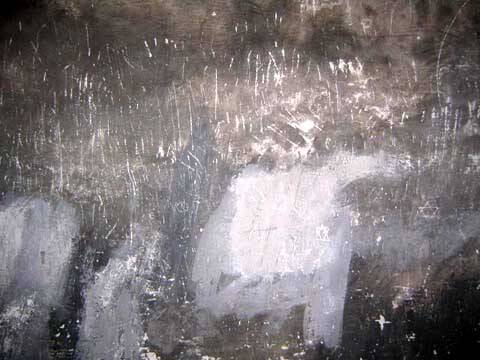
Holocaust deniers will often ironically point you to the "scratch marks on the gas chamber wall those desperate victims made" and then ask you how this is even possible if the chamber was partially reconstructed by the Polish-Soviet authorities in 1947. They lay out the word "partially" as a bait because anyone who goes on to defend the scratch marks by saying this part of the wall along with the scratch marks is genuine, will take the bait hook, line and sinker, as the deniers will then ask them to prove how human nails are even physically able produce long scratches like those on the wall without snapping off.
According to the Auschwitz museum[1] the scratches were not made by the victims - they were made by tourists who, over the past decades, have thought it funny and cool to scratch and deface what should be a very sombre and horrific site with sharp tools such as their keys. If you wish to independently verify the above, simply contact the Auschwitz museum directly and ask them about it. They've gotten a number of inquiries. Or, you know, you can just look at the Stars of David present in the picture, as well as the letter P.
Given that the chamber sees a million tourists each year, and with there often being no museum personnel keeping watch inside, it's not surprising that the walls have become subject to vandalism.
source:
[1]: https://twitter.com/AuschwitzMuseum/status/829719431962038273
More "souvenirs" tourists leave behind at Auschwitz-Birkenau
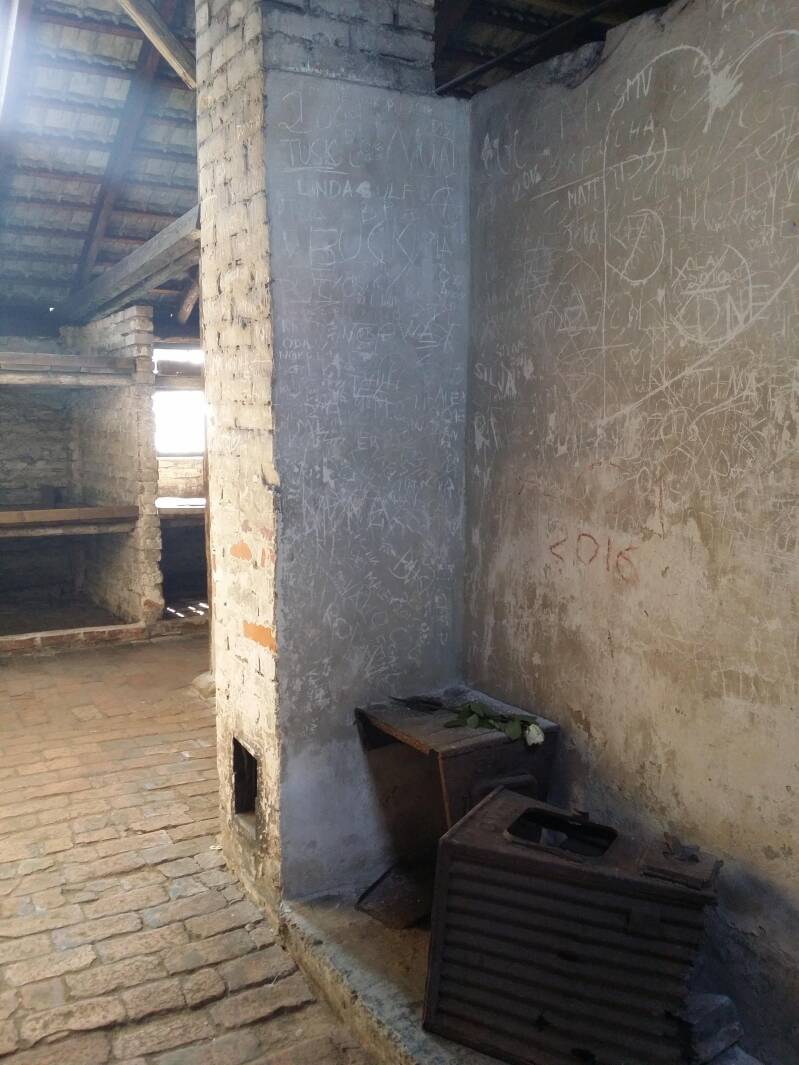
Tourists can indeed be the most destructive cunts to disgrace Auschwitz-Birkenau since the end of the Second World War. The picture above showing the interior of one of the women's barracks is another example - including marking the current year this blog post was written in - of how Auschwitz-Birkenau is being damaged and defaced and I'm not even going to say these are deniers like Leuchter who chiseled into the walls many years ago for his "Leuchter report". Rather, these are the kind of brain damaged, self-absorbed pricks that want to leave "their mark" on any famous place they visit. If I were in charge of the museum and caught any of them I'd make sure they would spend the night tied to one of the trees near Kremas IV and V.
Denier infographic about Krema I's "gas chamber door"
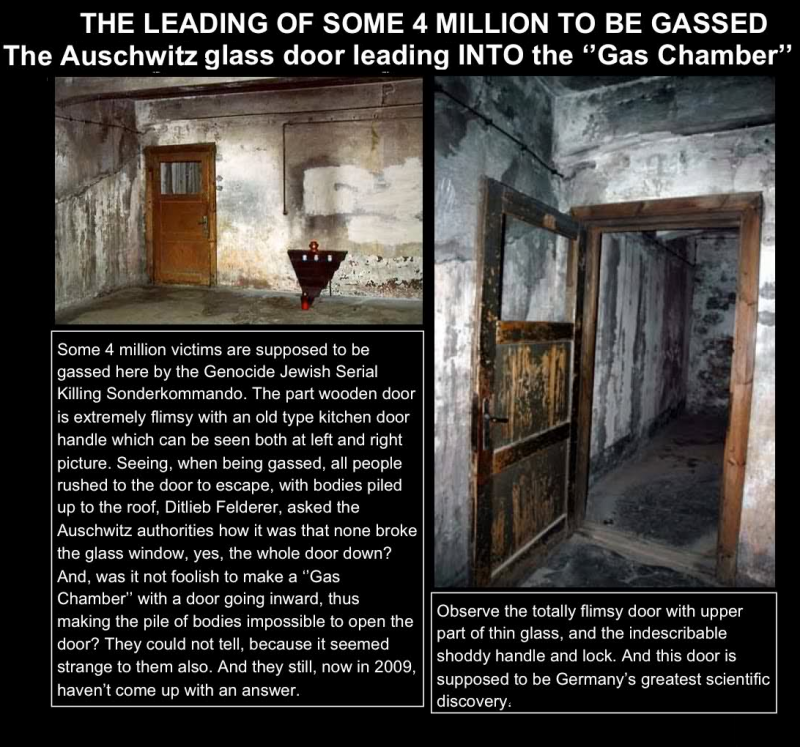
Holocaust deniers parade the picture of this door (one of two wooden doors in Krema I's gas chamber today) around as penultimate proof to convince people that nobody was gassed, in Krema I at least. Unlike the average person they are trying to convince, the (at least more intelligent) deniers themselves know full well that gassing at Krema I had stopped by 1943, and the building was converted into an air-raid shelter by 1944, as explained earlier.
This wooden door leads from a storage room for spare gratings into an area called the "wash room" - clearly marked as such on the sign outside (http://i.imgur.com/duS3xZA.jpg) as a. and b., respectively, put in front of Krema I for all to read. The wall section separating the wash room from the actual former gas chamber no longer exists. So the door pictured never led into the gas chamber, and is therefore not the original gas chamber door.
A denier pic comparing American gas chamber doors to the ones in Auschwitz
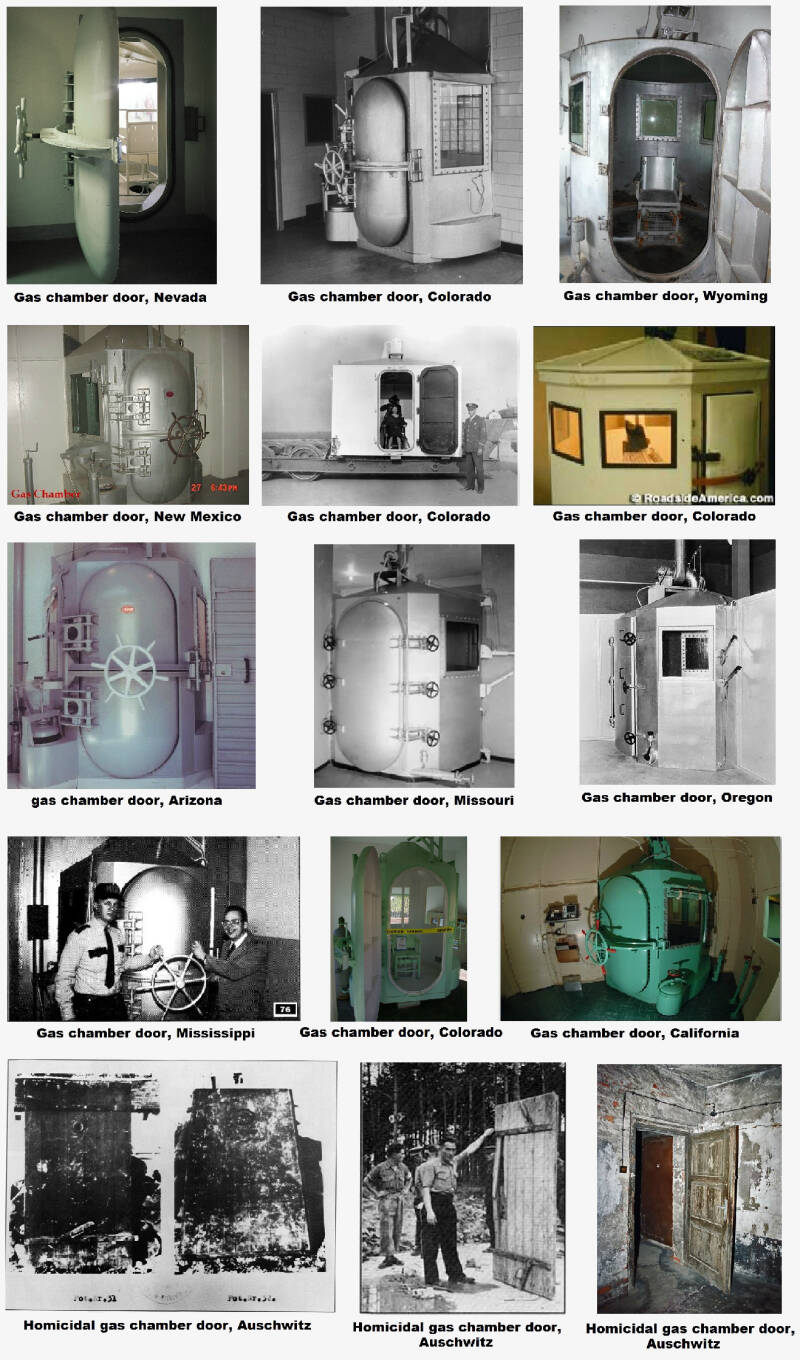
In this widely circulated pic, holocaust deniers try to make people aware of the existence of gas chambers for executing people in the United States and use them as proof of how "complicated" gassing with Zyklon-B really is, and how the lack of such doors in Auschwitz is proof no homicidal gassings could have possibly taken place there. Both Fred Leuchter and Robert Faurisson are pretty hysteric regarding this.
Already, part of this "infographic" is a flat-out LIE obviously intended to only fool the clueless, because the door pictured on the bottom right is NOT the homicidal gas chamber door of Auschwitz's Krematorium I, and isn't even claimed as such by any historian or reputable camp authority. What you are seeing instead, is the 2nd of two wooden doors in Krema I's enlarged gas chamber today, a building that underwent renovation in 1943 after homicidal gassings had been moved to Birkenau, and which was subsequently used as an air-raid shelter, as is stated in the sign in front of the building brought up to explain this to the million or so tourists that visit it each year (imgur.com/duS3xZA). I have explained what the 1st wooden door is previously (imgur.com/1bm1yrw). This 2nd one (the two are distinguishable from one another in that this one does not have a missing wooden panel in the upper half) leads into a small vestibule built in 1944 in front of the other exit of Krema I (you can see the far sturdier metal door behind it).
Now let's look at the other two doors in the infographic's bottom left. The denier narrative goes, that these doors were claimed to be homicidal gas chamber doors (note the hemispheric metal grid over the peep-hole on one of the left one's sides), but in reality are innocent delousing chamber doors, as deniers do not believe in homicidal gassing, but do accept Zyklon-B's historical use for fumigation and delousing.
Even if the two doors on the bottom left are "just" doors of delousing chambers, holocaust deniers still have a problem: Considering these doors are made out of wood, and therefore "flimsy", and therefore Zyklon-B gas leaking out, the deniers would have to abandon their argument about Zyklon-B being used for delousing as well, because using their same, frequently toted "leaking is lethal" argument they use to discredit homicidal gassing, the case can be made that even the delousing chambers would kill everyone around them due to gas leakage. And keep in mind the delousing chambers were located far closer to the (women's) inmate barracks than the homicidal gas chambers, as shown on the Birkenau camp map here: imgur.com/wdxcRbF. Make up your minds, deniers - either these doors saw historic use involving Zyklon-B, or you need to abandon your stance on delousing as well.
Krematorium II and III, located underground, had a ventilation system proven both by testimony and documents (blueprints) here: (imgur.com/cXSdJkz), here (imgur.com/17mmlGM), here (imgur.com/KxRpFZ5), and here (imgur.com/mBd6lps), while the other gas chambers were at ground-level and therefore easier to ventilate simply by opening the doors and chimney vents. We know from chemistry that Zyklon-B is lighter than air, and by venting out into the open air it rapidly loses its lethality[1]. This is the reason why the aforementioned American gas chambers also vented the gas via exhaust tubing into the open.
Now then, deniers will have to make up their minds whether Zyklon-B that escapes from high concentrations in a room and mixes with the air of the surroundings continues to be lethal (in which case no delousing could have taken place either using said flimsy doors), OR is only lethal within the chamber and loses its lethality when escaping the chamber, in which case the hermetically sealed American gas chamber doors are NOT a necessity but rather merely an excessive security measure that complied with stringent American safety standards.
Long story short: American gas chamber doors do NOT debunk the doors used for the Auschwitz gas chambers, which are also NOT the wooden doors still existing inside Krema I today.
But we still have one more argument from deniers, and that is about how easily these doors (they still use the picture of the wooden ones) could have been broken down by those trapped inside. I address this here: imgur.com/q9Qrcf3
Source:
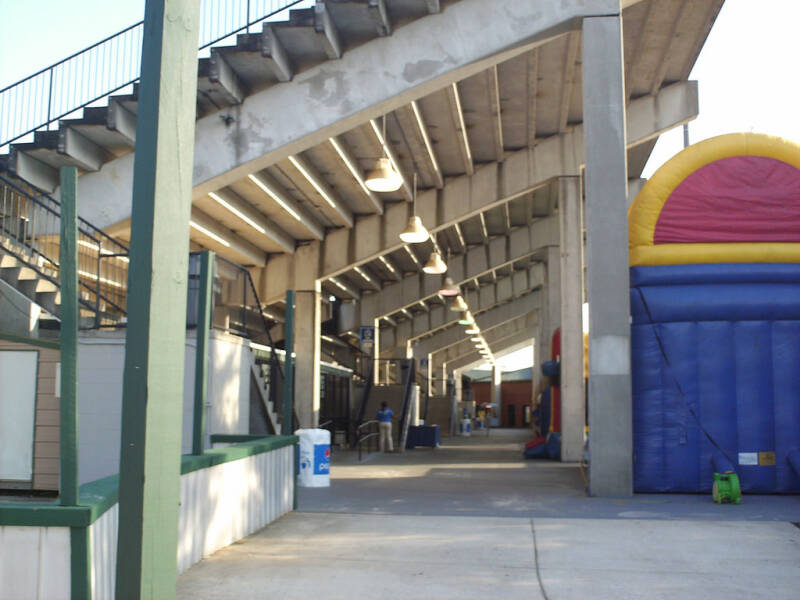
[bleachers seen from below]
Those doomed to die "breaking down the gas chamber doors"
Holocaust deniers often ask the question, why those doomed to die once locked in the gas chambers did not break down the door, especially if, as they claim, the door looked nothing like one of the American gas chamber doors presented in their infographic above.
But the question I have to ask these deniers in return is, how do a group of people who are naked and unarmed break down a door?
The answer would be by using their bodies as a battering ram, i.e. by running up to it and smashing their torsos/shoulders against it in unison to maximize force applied to the door. However, this only works with as many people as the door is wide, i.e. maybe 5 or 6 people.
Another crucial requirement is that there should be enough room in the chamber for the batterers to gather speed and thereby force as they run up to the door and smash themselves against it. Which is not the case if the room is packed with people.
Why do I only say 5 or 6 people that can realistically open the door? Simple: What you need to realize, is that the force vector does not add up in a linear fashion. Adding more people into this equation is futile because their additional manpower will not add up the way you might think it does. We are talking about a writhing mass of soft bodies here. All you will achieve is a bunch of people pressing into each other and cracking their arms or getting their torsos quashed on the backs of the ones in front of them as a result as others behind them crash into their backs.
And this is assuming they're all thinking like a hive mind and doing a combined "heave-ho" effort to break down the door, and not a panicking mass of people grappling in all directions. We are presented with a whole host of additional problems:
First of, the idea to break open the door coming to the minds of those closest to the door. Would you expect a large group of people who had been deceived into undressing just moments ago in the belief they would be receiving a shower undergo this realization quickly enough that their doom was imminent and they should do something about it? And even regarding those in the chamber who realized it, the question remains how close were they to the door? I'd say tough luck if you realize something is horribly wrong, but are on the far end of the gas chamber with over a thousand people between you and the door you came in.
Secondly, communication: these Jews were from different parts of Europe. I doubt they would all have a common language to communicate, as English wasn't such a universal language back then as it is today. We have Dutch Jews, German Jews, Czech Jews, Ukrainian Jews, Hungarian Jews, and of course lots of Polish Jews, and you have to ask yourself whether they all spoke some dialect of Yiddish, or rather just the language of their country.
Not to mention that these people aren't healthy, well-fed individuals like us, but mediocrely fed Western Europeans from wartime 1940s at best, and malnourished Eastern Europeans who had been living for years in Jewish ghettos at worst.
And then we have another problem: those guys breaking down the door in unision I mentioned earlier, you had men in mind, didnt you? Too bad you missed the part where the fit and able-bodied were the ones who passed the Selektion at the Rail Ramp and the ones sent to the gas chambers were the rest, i.e. the ones that didnt make the cut, namely the elderly, the pubescent, the children and infants (and I presume the mothers they belonged to). So the only demographic in said gas chamber that have some kind of chance of breaking down the door are the elderly men, the boys under 15 years of age, and the women cradling their infants, provided they gave them to someone else to hold on to while they joined the others. Are you realizing how ridiculous we are getting at this point? But we're not done yet.
The SS were already pouring in the Zyklon-B from the holes in the roof (Krema I, II, III) or side walls (Krema IV, V), and the combination of a pre-heated gas chamber (as documents later will prove) and over a thousand warm bodies in the room mean the pellets begin their outgassing almost immediately. At best, the people trying to break down the door only have a few minutes to do so before the room is full of HCN that their vitals begin to fade. And before this sets in they already are presented with the scenario of hearing those closest to the inlets coughing, retching, crying, screaming in panic, and the latter reactions spreading through the rest of the crowd very fast. So before their own strength fades, their minds are already taking a severe psychological beating. Under such duress they must break the door open, and hammering against it with their fists won't cut it, I think we can all agree on that. Oh and the lights were switched off. Can you continue to think straight and communicate with others under such circumstances?
http://www.holocaustresearchproject.org/othercamps/auschwitzgaschambers.html
Sometimes the following video has been presented as proof that even concrete breaks down to the weight of the people:
But notice how it broke BENEATH them, i.e. due to their combined weight, i.e. a vertical force vector that indeed increases when more people are present. This cannot be extrapolated to a horizontal force vector applied against a door to force it open if there's a mass of panicking people on the other side. We finally get to the picture itself, which is what I think the stadium's seating arrangement's lower section in the video looked like. It wouldn't surprise me if a huge weight of people causes flimsily constructed concrete with nothing underneath it, to break.
A couple more things to consider, now that we have established how difficult it is for the people within the gas chamber to make any kind of coordinated effort to break down the door using their strength:
First off, the only fully intact homicidal gas chambers that survive today is (haphazardly restored) Krema I at the Auschwitz I Stammlager (and I say haphazardly because its current state neither reflects its layout during its use as a gas chamber + crematorium, nor its layout when the SS used it as an air raid shelter in 1944/45), as well as one at Majdanek and Mauthausen. Krema II, III, IV and V, all located in Birkenau, as well as the White House and Red House, are either ruins or razed to the foundations. As far as I am aware, none of the original gas chamber doors of any Birkenau gas chambers survived the war, and therefore cannot be examined as to how sturdy they were. What survived in Birkenau, were some doors of the delousing chambers located elsewhere in the camp, as well as outside doors leading into Krema I, which I will show below.
Even if the doors had survived, the buildings (e.g. Kremas II, III, IV, V) have not, therefore we also cannot answer the question whether the doors opened inwards or outwards apart from blueprints where they, in fact, do open outwards. Logically speaking it makes sense for the deniers to say they should have opened outwards, as otherwise it would be extremely hard to open them after a gassing, as the bodies would be stacked against them on the other side. At least for Krema I we can say that one of the gas chamber doors opened outwards, and the other both inwards and outwards, as demonstrated in the blueprint seen here: http://i.imgur.com/aitbmff.jpg. If you pay close attention, you can also see on the blueprint that the 1st wooden door seen today opens inwards. But this is irrelevant, as this antechamber (wash room) was not part of the gas chamber in the first place! Once again, it only appears so because the dividing wall has been torn down and therefore the gas chamber is larger today than it EVER was. Even the smarter holocaust deniers acknowledge (sometimes even point out) how there are marks on the walls of the gas chamber where previously dividing wall sections had once been. The fact that the 2nd wooden door on the far end of the gas chamber also opens inwards is irrelevant because this vestibule did not exist until the building was converted into an air raid shelter in 1944, as shown both on the sign outside (http://i.imgur.com/duS3xZA.jpg) and demonstrated by the complete absence of said vestibule + door in the blueprint (http://i.imgur.com/aitbmff.jpg).
Mauthausen's relatively small gas chamber claimed the lives of "only" about 3000 people throughout its existence, so we aren't faced with the situation of over 1000 people in the room there. In any case, the Mauthausen gas chamber has reinforced doors that I will also show below. From these realizations, it is hard to judge how sturdy Krema II, III, IV and V's gas chamber doors really were, but what I have been able to provide, is an account of how unlikely it would have been for the panicking, naked, unarmed people from different parts of Europe, not knowing each other and who didn't pass the Selektion, inside (in a rapidly toxifying atmosphere, to boot) to breach it.

This is the door (with peep hole) on the entrance of Krema I. You can see on the sign outside (http://i.imgur.com/duS3xZA.jpg) that this door does not lead directly to the gas chamber (labeled c on the sign), but to an antechamber. Of course I cannot rule out that this isn't the gas chamber door taken from the inside and remounted on the exterior as the SS converted Krema I to an air-raid shelter in 1944. In any case, it doesn't look flimsy to me even 70 years after it was installed. Maybe to a group of 200 pound weightlifters, but not to me.
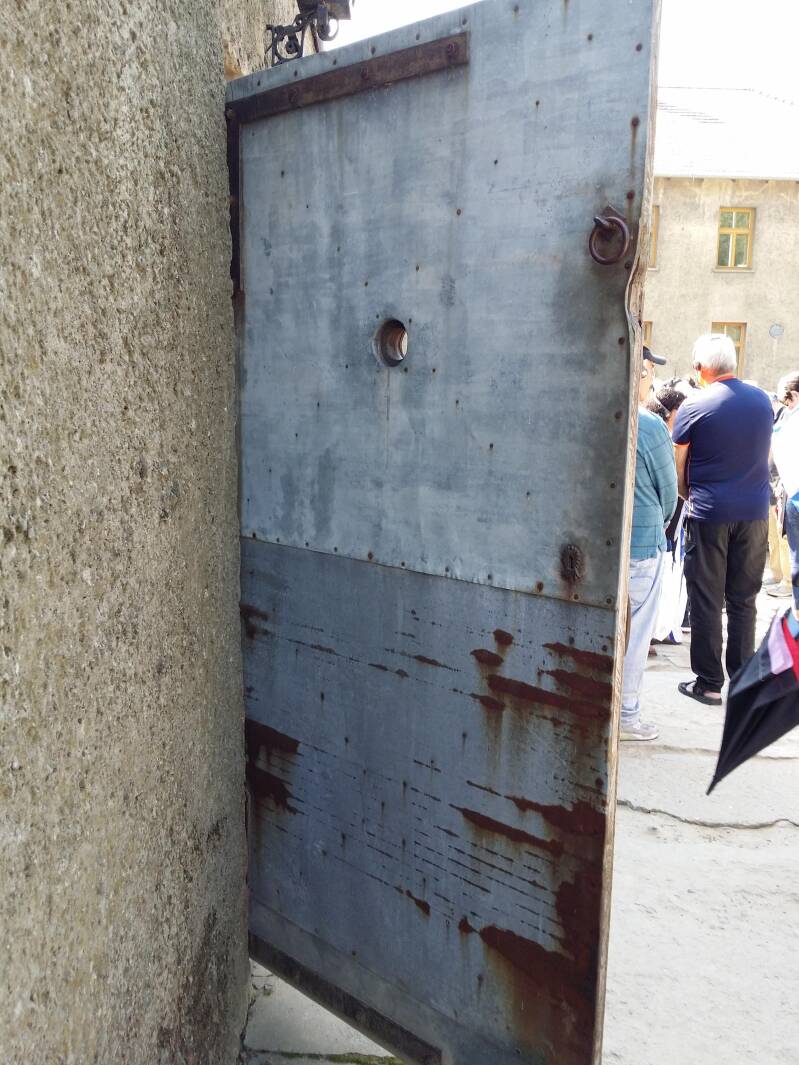
Reinforced with metal on both sides. There's a keyhole on the outside, but you won't see it on the door's inside.
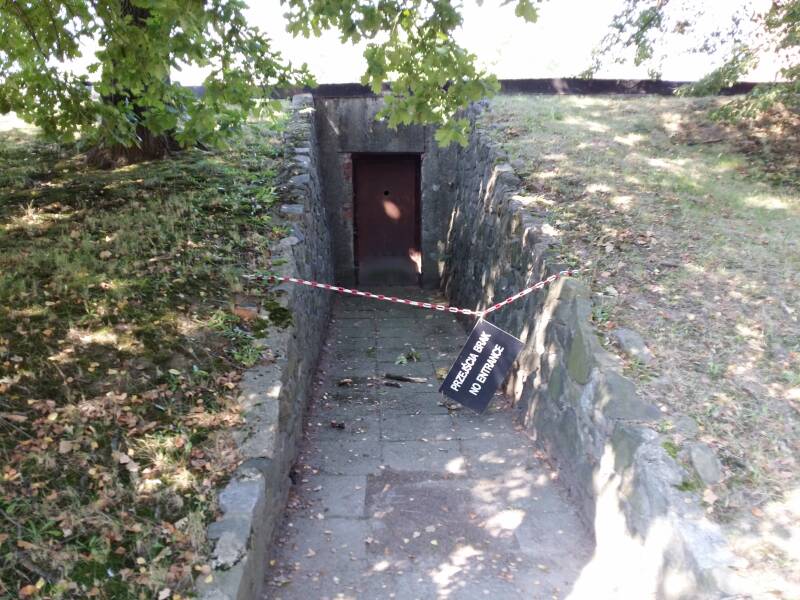
Once again, if you look at the sign outside (http://i.imgur.com/duS3xZA.jpg), this exit did not exist while Krema I was operated as a homicidal facility. However, an entrance nearby existed leading directly into the back room of the crematorium. Nevertheless, we have another sturdy door here, whose other side will follow in the photo below.

An equally sturdy looking door, mounted on the building's exterior as Krema I was converted into an air-raid shelter. This exit, as well as the additional vestibule ("air-lock") constructed inside the gas chamber, did not exist until 1944.
So now we have two different sturdy gas chamber doors mounted on the two entrances/exits of Krema I leading to the exterior.
Is it so hard for deniers to imagine these could be the two doors of the original gas chamber the Nazis remounted FROM the interior TO the exterior when they converted Krema I into an air raid shelter? Namely one leading into the gas chamber from the wash room whose wall no longer exists today, and the other leading from the gas chamber into the crematorium? Again, see http://i.imgur.com/duS3xZA.jpg. There is no door between the crematorium and the gas chamber today.
Some deniers have pointed out these are air raid shelter doors even advertised as such. Well, obviously there was no company in Germany manufacturing Jew-killing gas chamber doors now, was there? I have no idea what deniers want to achieve with an argument like this. You kill people with pesticide, not a "people killer". Similarly, you lock people in with air raid shelter doors, not "people trapping" doors.
But in a sense, when David Irving said: "More women died on the back seat of Edward Kennedy's car at Chappaquiddick than in the gas chambers at Auschwitz", there was one grain of truth in his otherwise ridiculous sentence: the way the gas chamber at Krema I is presented to tourists today in its current configuration (with the two wooden doors, with the additional concrete vestibule on the far side; with the entrance to the crematorium shifted by about a meter, with the missing wall section that separated the original's wall from the wash room thereby extending its area) - indeed nobody was gassed in the (enlargened) room in THIS current configuration.
However, this does NOT mean that this isn't the exact location where once the original homicidal Krema I gas chamber stood. And I don't even mean in the next room, I mean exactly occupying roughly 4/5ths the area today's Krema I gas chamber occupies. Therefore anyone calling the Krema I gas chamber today a 'fake' needs to be smacked on the head with a copy of J.C. Pressac's "Auschwitz: Technique And Operation of the Gas Chambers" for being a nitpicking prick.
And speaking of Irving (who I will address in more detail much later), he no longer denies the extermination aspect of the holocaust but is only haggling with numbers and locations. In fact, even on denier central, the CODOH forums, all I could sense was frustration:
"Irving has long ago become an embarrassment to our cause"
- Steven Willow
"I totally support [Jürgen] Grafs view of what caused Irving to join the revisionist position in the first place. His assumption was, that the Leuchter report would lead to the total collapse of the hoax, and thus wanted to be among the "winners". This however, proved to be a total miscalculation..."
- ganglere
"Instead of stabbing revisionists in the back with his recent silly thoughts about gassings, Irving might have simply kept his big mouth shut for a change since he has no "real" idea as to what he is talking about anyway in this regard. Could it be that Irving sees some big pot of gold waiting somewhere if he makes enough brownie points with the Jews? Gee, I wonder? How much revisionist money will it take to get David Irving to switch sides once again?"
- Friedrich Paul Berg
The Swimming Pool

A favorite example of holocaust deniers is the Auschwitz I Stammlager's swimming pool. They argue that the presence of an "Olympic-size swimming pool, complete with diving boards", where the occasional water polo match was held, shows that Auschwitz was really a rather benign place, almost a holiday resort, and therefore could not have possibly been a center of extermination. For the deniers, the presence of a swimming pool automatically turns a concentration camp into a nice place. Somehow, the swimming pool, by its sheer presence, debunks gas chambers and other cruelties going on elsewhere in the gigantic camp complex. Yes, this is revisionist logic in full swing. Apparently, good and bad things cannot exist in the same place.
To begin with, revisionists do NOT tell you that the swimming pool (commissioned by camp commandant Arthur Liebehenschel[1]) worked as a water reservoir for the purpose of firefighting and that the pool was only accessible to SS men and privileged non-Jewish prisoners who were at the top of the complex prisoner hierarchy and employed as inmate-functionaries in the camp, including Polish Catholics or German political prisoners.
To evidence this claim that the pool was off-limits to most, let us hear what survivor Marc Klein has to say:
Klein's exact words were "Il est à noter que seul les prominents [individus privilégiés dans le vocabulaire des camps] bien nourris, exempts des travaux les plus pénible, pouvaient se livrer à ces sports"[2]
which translates to:
"It should be noted that only the very fit and well-fed, exempt from the harsh jobs, could indulge in these games which drew the liveliest applause from the masses of other detainees." This brings us to the second point which revisionists make sure NOT to educate the common folk about: The term "Auschwitz" is used broadly to describe three distinct camps that were about a mile away from each other: Auschwitz I Stammlager, Auschwitz II Birkenau and Auschwitz III Monowitz. The presence of the swimming pool in the comparatively tiny Auschwitz I Stammlager with its few thousand inmates, originally built for political prisoners, and that's where the pool was, does not say anything about the conditions for Jewish inmates, and does not challenge the existence of an extermination program, predominantly carried out a mile or so away in vast and sprawling Auschwitz II Birkenau which could hold 100,000 prisoners at a time. For reference, see the map at: i.imgur.com/R6ZGEmF.jpg
The overwhelming majority of prisoners (and Birkenau housed over 100,000 of them) NEVER got anywhere NEAR this small pool - this is fact.
So what we witness here is typical revisionist scholarship at its finest: a classic generalization tactic from things which were limited in their application (i.e. from the relatively decent conditions provided to the Nazis running the camp, and a small number of privileged prisoners who were their most loyal lapdogs quartered here) to the entire camp population, especially everyone over at Birkenau, to then publish scholarly conclusions such as 'oh look how great the Jews had it in this camp we only keep hearing horror stories about!'
Why is this important? Because the Auschwitz swimming pool is a key factoid with which revisionists seek to lull an unsuspecting target audience into beginning to doubt the holocaust: the swimming pool argument deniers present, is a complete red herring with the sole purpose of baiting the average person on the street into denial, because clearly he didn't hear about this in school, and clearly it exists, so clearly the denier who told him about this was not lying, therefore there's something fishy about the entire camp and he was lied to his entire life.
The idea that, after years of deliberate persecution, anti-semitic laws, pogroms, destruction of synagogues, ghetto starvation, massacres, and so on...that the Nazis forcibly removed Jews from their homes and transported them hundreds of miles in cattle cars...to a friggin holiday camp complete with swimming pools, brothels, and 'work to set them free'...is just such a load of COMPLETE AND UTTER BOLLOCKS that any denier espousing it seriously needs the most secure straight jacket that can be found.
Sources:
[1]: Barbara Cherish, "My father, the Auschwitz commandant", 2009
[2]: Marc Klein, "Auschwitz I Stammlager", p. 258
Horse grooming in Babitz, one of the Auschwitz sub camps

This is another picture used by deniers to show us just how nice the prisoners of Auschwitz really had it. Except this is neither the Stammlager, nor Birkenau, nor Monowitz. Taken from the SS Auschwitz album, this image was most likely taken in the Babitz sub camp, near the depopulated village of Babice, opened in the first half of May 1943. About 180 women were placed in its former school building, and an equal number of men in a nearby wooden barracks. The windows of the building occupied by the women were walled up or secured with barbed wire. Inside were sleeping rooms with bunk beds, offices for the SS men and female overseers, a first-aid room, a washroom, and a kitchen. Food was delivered from the Birkenau camp. Two barns, a stable, storage sheds, and a shed for harnesses were built inside the barbed-wire fence.
The women prisoners were employed caring for and milking cows, clamping potatoes, spreading manure, and weeding and earthing up cabbages and beets. The male prisoners groomed the horses, plowed, mowed hay, and harvested. When the army requisitioned some of the horses in the spring of 1944, women prisoners were harnessed to the plows with long ropes. The supervisors of the women’s Kommando were SS Aufseherinnen Erna Kuck and Johanna Bormann, in turn; SS-Oberscharführer Rosenoff was director of the men’s Kommando. The women’s Kommando was liquidated and the women transferred to Birkenau in July; the men’s Kommando remained in Babitz until January 1945.
Greenhouse in the Rajsko subcamp
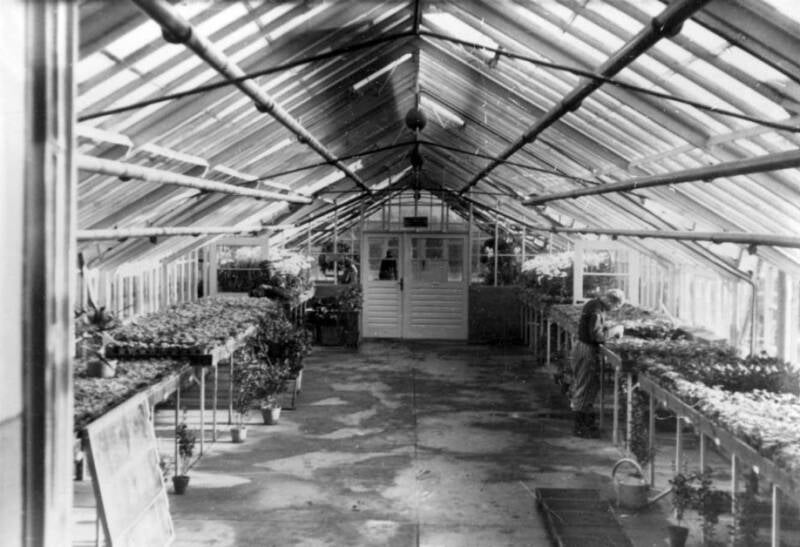
What we see here is most likely a photo taken by SS Unterscharführer Dietrich Kamann in 1941. These were built by slave labour in the German-occupied Polish village of Rajsko - a subcamp of Auschwitz-Birkenau, a few miles away from Birkenau.
Hundreds of female Auschwitz prisoners were forced to work tending flowers, plants and vegetables for their Nazi captors and also help conduct agricultural experiments: During the first part of the war the greenhouses were both the base for initial experiments in rubber production through the use of specially grown dandelions, and later growing vegetables and flowers.
The never reused glasshouses have remained untouched on private land since Auschwitz's liberation, and are derelict today.
SS-guard and holocaust denier Thies Christophersen was stationed here, in the Rajsko subcamp, because he knew a thing or two about farming. He is the author of "Die Auschwitzlüge" (The Auschwitz Lie). Deniers use him as prime witness that no homicidal gassings took place in Auschwitz, since Thies Christophersen "was stationed in Auschwitz", and he himself said he never saw any gassings (although in Die Auschwitzlüge he actually does not say this and rather says nothing at all about homicidal gassing).
But here's the catch: In an hour long interview he gave to fellow denier Ernst Zündel, Thies Christophersen himself admitted live on cam that he had NEVER been to Auschwitz I Stammlager and only seldomly visited Birkenau. So let me get this straight: this guy never spent much time at the camps where the extermination took place, spent most of his "Auschwitz" duty in a small sub-camp miles away, but is supposed to be an authority and prime eye witness to (a lack of) extermination? Don't make me laugh.
What's more, in another interview aired on the film "Wahrheit macht frei - Dokumentation über Neonazis & Holocaustleugner, Deutschland (1991)" Thies Christophersen actually admitted that he left the Nazi atrocities unmentioned in his book due to him being biased [toward the Neo-Nazi cause]. If they hadn't taken place at all, then this is not how he'd have worded his sentence. Clearly this "witness" is a liar.
The Stammlager's theater

Just outside the fence on the west side of the prisoner compound is the so-called theater. The building was built before World War II. During the camp's history, this building served as a warehouse for prisoners' confiscated belongings, and also a storage site for Zyklon B. Carmelite nuns moved into the former theater building in 1984, and in 1988 erected the large cross in the adjacent execution site (many Polish prisoners, including Catholics, were murdered there). The nuns moved out of the Theater building in 1993, which remains empty, but the large cross remains at the gravel pit site.
However, it is also true that during the camp's operation, artists performed here in cultural programs provided for the SS men in the camp garrison. The German newspaper Die Zeit carried a long article on the subject by the German historian Ernst Klee, titled “How German Artists Kept Their Compatriots in a Good Mood while They Were Busy Murdering.”
Klee’s research shows that at least several hundred actors, musicians, singers, and writers took part in artistic events at Auschwitz during the years when the camp was in operation (1940-1945).
Klee draws attention to an account by one of them, Dieter Borsche, who was then a theater director in Breslau (Wrocław). Documentary filmmaker Joseph Wulf recorded Borsche’s account shortly after the war. Borsche tells about how he appeared at Auschwitz over the winter of 1943 for the camp’s SS sentry units. The actors were surprised that, despite the cold weather, the prisoners were dressed only in striped camp uniforms. Borsche states that SS men told him that theatrical troupes appeared frequently at the camp.
Kurt Knittel, a schoolteacher in civilian life and an Unterscharführer SS during the war, organized the cultural program at Auschwitz. In October 1941, he was appointed head of the department responsible for the ideological indoctrination of the camp personnel. Klee lists numerous cultural events held in Auschwitz and contrasts them with the crimes being committed in the camp at the same time.
“An evening devoted to ‘Goethe—The Serious Side and the Lighter Side’ . . . will be held at 8:00 PM on Monday, February 15, 1943. This event is, especially for Volksdeutsche, a good opportunity to learn about the highest achievements of German culture,” reads an invitation signed by Hauptsturmführer Robert Mulka, who was sentenced after the war to 14 years’ imprisonment for his crimes.
On the afternoon of February 23, 1943, writes Klee, 39 Polish boys aged 13 to 17 were killed in block no. 20 by injections of phenol to the heart. At 6:30 PM that evening, a theater from Mährisch-Ostrau (Ostrava, now in the Czech Republic) performed the operetta Princess Greta. “Since the performance begins relatively early, the time for the end of work in the camp and the evening roll call have been moved to an earlier hour,” reads the invitation.
On May 21, 1943, the orchestra of the Kattowitz opera played works by Haydn, Mozart, Schubert, and Dvorak for the SS men. “The arrangements are easy to follow, and therefore, even for people with no taste in music, this was not a waste of time,” noted camp commandant Rudolf Hoess, with satisfaction, in his diary.
In May 1944, when almost half a million Hungarian Jews were arriving in Birkenau in transports designated for immediate extermination, cultural life at the Stammlager was flourishing. Camp posters from the period announce a performance of Gerhart Hauptmann’s The Beaver Coat by a theater from Beuthen (Bytom), a Viennese evening featuring the best artists from the city on the Danube, and a guest appearance by a troupe from Gleiwitz (Gliwice).
As usual, deniers mention the theater in the Stammlager (chiefly existing to provide some form of escapism for the SS personnel from the effects of camp life on their minds) as proof the place was not so bad after all...yeah right. I guess those negligibly few musically and theatrically talented inmates that performed there did get to escape hard labor, but that's about it. The theatre's existence and the numbers of people it entertained, was minuscule in comparison to the amount of people interned in the entire camp complex, which is probably the reason why you wont find this highlighted in every Auschwitz book or movie compared to ever denier book where they make this the # 1 priority.
Source:
The Angora project
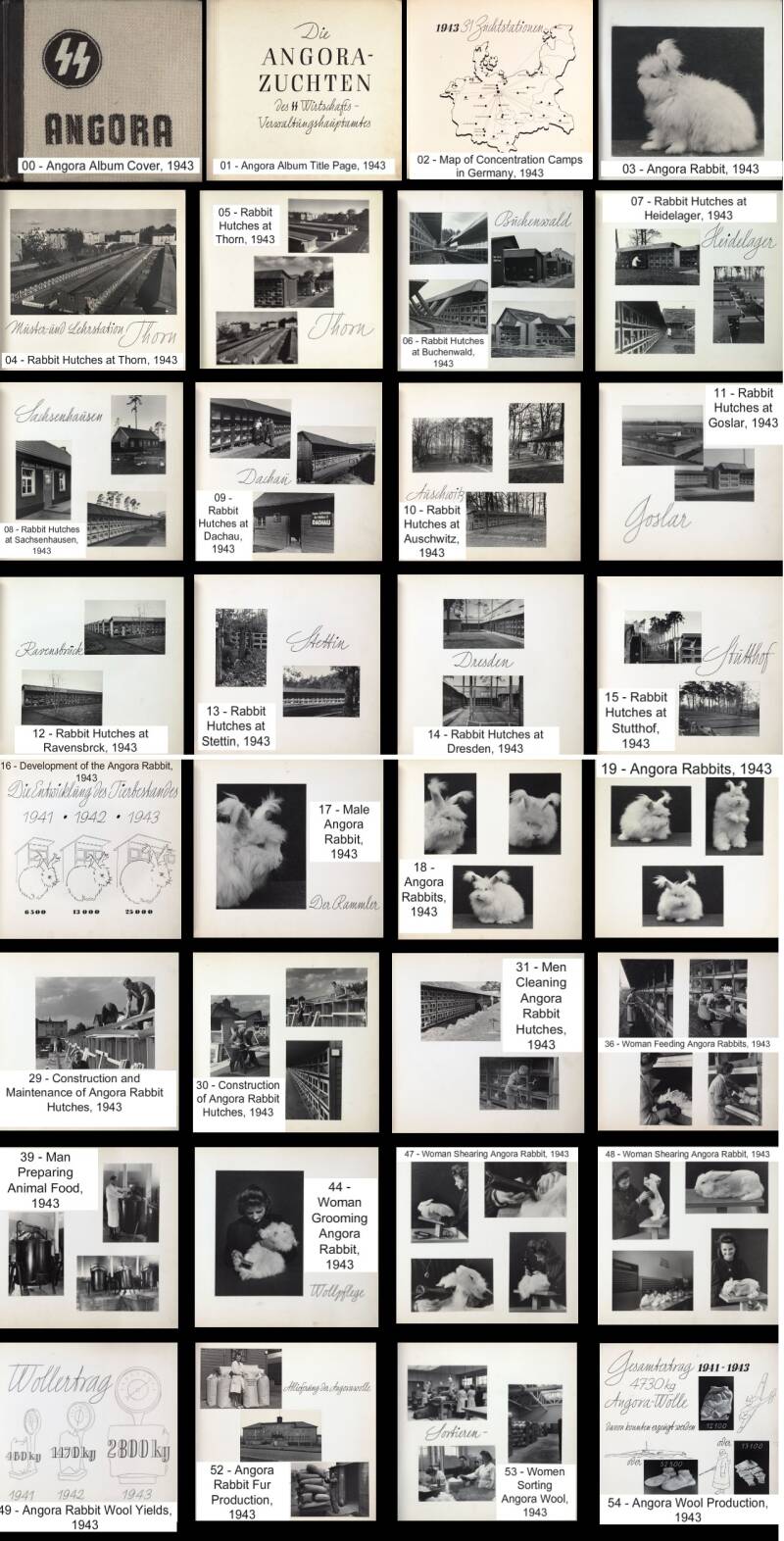
The album above shows angora farms in German facilities, including concentration camps such as Dachau, Buchenwald and Auschwitz. The Angora rabbit project was an SS project for breeding Angora rabbits. The objective was to provide fur for the linings of jackets for Luftwaffe pilots.
Himmler's Angora album, which he hid in a farmhouse with his other papers near the end of World War II, tells the story of the Angora rabbit project that operated in the camps. Chicago Tribune war correspondent Sigrid Schultz found the book near Himmler's alpine villa. Today, the book is housed at the Wisconsin Historical Society. Photographs, charts and maps from Himmler's Angora are among the more than 27,000 images available in the Wisconsin Historical Society's digital collections. Angora was featured in a Wisconsin Historical Images online gallery in March 2007.
One of the denier trains of thought is that if cute things existed in horrible places, those places couldn't have been horrible. This is why they bring up the Angora project in their attempts to deny the holocaust. And of course also because comparatively few people know about this project, so when a denier drops this info on them and they say "no you are lying! there weren't any bunny rabbits in Auschwitz! Wtf is wrong with you", the denier can then take his sweet time to provide proof and thereby sow the seeds of doubt in the mind of the person(s) he is trying to convince - this is how holocaust deniers operate.
Auschwitz football team of 1944 (Allies prisoners of war)

Alongside the main Auschwitz complex was a prisoner-of-war camp known as Auschwitz E715, located near Monowitz, where the inmates included several hundred British soldiers.
Indeed, when journalist and author Duncan Little stumbled across the story of the British prisoners of war who worked as slave labourers alongside Jewish Auschwitz inmates at the IG Farben chemicals factory next to the camp, he was shocked. He recalls: “I was at the national archives researching a television programme I was directing and I stumbled across a document about a British man who had been flogged. I wasn’t aware of any British prisoners at Auschwitz. I began to do some more picking and I realised there were many British POWs there.” Little made contact with three of those who experienced the horror of the death camp: Brian Bishop, Doug Bond and Arthur Gifford-England. Through their experiences, and archive documents he unearthed, Little put together a book, "Allies in Auschwitz", which tells their remarkable story.
The regime of the POWs at Auschwitz was not significantly different from those elsewhere. They received Red Cross parcels and, nominally at least, had the protection of the Geneva Convention, but they had to endure the freezing temperatures of the Polish winter and witnessed the extraordinary suffering of the Jewish inmates.
Little says: “The documents clearly show that Jewish inmates were beaten and killed at the IG Farben factory — the British prisoners witnessed that. They saw people being hanged and they smelled the smoke pouring out of the crematorium a couple of miles away. One British prisoner complained about being forced to work for the German war effort at the factory, at which one of the managers pointed his revolver and said: ‘This is my Geneva Convention’.” In fact, the British were not immune to Nazi brutality. One soldier, a Corporal Reynolds, refused to climb girders because it was cold and he did not have appropriate clothing — he was shot dead on the spot. There was retribution against other British personnel too.
However, in the midst of the killing there were activities laid on for the POWs which would be familiar to anyone who has seen "The Great Escape" — there were indeed organised games of football - but the British PoWs held at Auschwitz never played football in Birkenau, they played near their own camps which were situated close to the industrial complex at Monowitz. You can see the location of the British POW camp in the picture that follows. But like Jewish inmates, the British prisoners also went on the death march of January 1945, when the camp was evacuated in the face of advancing Soviet forces.
Little says: “The POWs followed the same route taken by the Jewish prisoners a week to 10 days earlier, which meant that along the way the soldiers saw the dead bodies of many thousands of Jews. They were marching in freezing conditions with very little food. They had to use their own resources to find things to eat. Ultimately, the horse which carried their rations in a cart was slaughtered and eaten.”
In the end, the POWs were abandoned by their German guards and liberated by the Americans.
Little feels that the testimony of the British troops is important — particularly in countering Holocaust denial. He says: “They were independent witnesses. It’s an important corroboration of the Holocaust.”
Location of the British POW Camp

A diagram of the Monowitz Buna Works, displayed during the Nuremberg IG Farben trial. This is where British POWs played football - not in Birkenau.
The Brothel
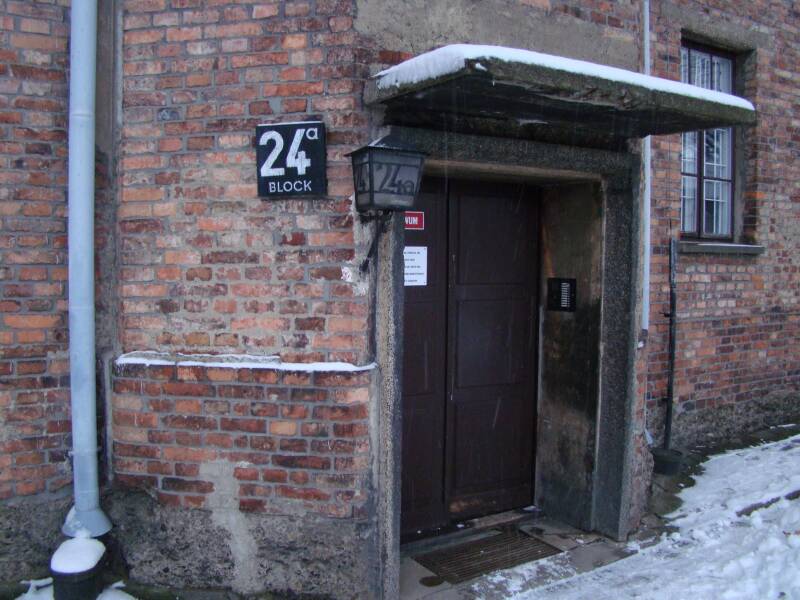
Fifteen minutes in Block no. 24...
Houses of prostitution for the use of prisoners functioned under SS supervision in the German concentration camps for several years. Until recently, however, there was a reluctance to speak about them.
Brothels operated in ten concentration camps on the territory of the Third Reich and occupied Poland. One of them was opened in Auschwitz in the summer of 1943. “It was located in Block no. 24. The first building on the left past the gate with the inscription Arbeit macht frei,” says Piotr Cywiński, director of the museum located at the site of the camp.
The women were recruited from among the prisoners. Some of them did so under compulsion, while others, mostly professional prostitutes, volunteered. “It was a choice between the house of prostitution or death,” explains Robert Sommer, a German historian who is working on a book on the subject. “Many of these women would have been sentenced to immediate extermination if they had not decided on the assignment.”
Only gentiles could avail themselves of their services. No Jews allowed. Even in the houses of prostitution, the SS remained faithful to the Nuremburg Laws. German men could sleep with German women, and Polish men with Polish or other Slavic women.
For decades, the subject of the camp bordellos was only whispered about. It was, of course, mentioned in the scholarly literature, and especially in prisoner memoirs.
“There is no room for illusions. The camp brothels were no humanitarian gesture on the part of the Germans. They placed them in the camps in order to humiliate us and cause dissension. To strip us of our higher feelings and reduce us to the role of animals who only work in order to sate their primal instincts,” says Jerzy Bielecki.
The greatest victims of this crime were the women who worked in the bordellos. The SS took no particular interest in their health or safety. Because the male prisoners were not given condoms, pregnancies were frequent. The women were then subjected to routine abortions.
Camp physicians carried out the abortions in a slipshod way, in primitive conditions. Many women suffered permanent injuries as a result. They were also treated brutally when the prisoners infected them with diseases.
“We have accounts of the condition these women were in when they were released from camp,” says Robert Sommer. “They were human wrecks, in both physical and psychological terms.” While researching her book, Christa Paul contacted two former camp prostitutes. “Even decades later, it was difficult for them to talk about it,” she says. “The things they did in the camp scarred them forever. After the war, they had trouble finding a place for themselves. None of them ever had children. They struggled with various psychological problems.”
Jewish Babies born in a concentration camp
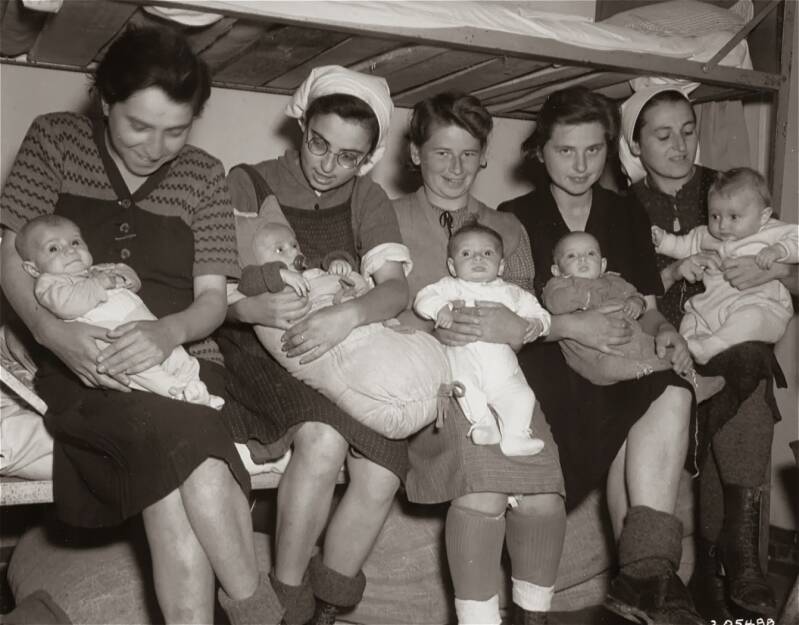
What we see here, is an image from the private photo archive of Miriam Rosenthal, born Miriam Schwarcz in Komarno, Czechoslovakia, on Aug. 26, 1922, an Auschwitz and Dachau survivor who married the Hungarian Bela Rosenthal in 1944, shortly before they were rounded up by the Nazis as Hungary could no longer protect its Jews. Some particularly dumb holocaust deniers make the mistake of parading this picture around as "babies born in Auschwitz", when in reality it shows an image of babies born towards the end of the War in Kaufering I, a sub-camp of Dachau located 50 kilometres west of Munich. Miriam Rosenthal was transferred from Auschwitz to work in an Augsburg Messerschmitt factory (yes, transfers of the able-bodied from Auschwitz to work at munitions factories was a thing) before she was taken to Dachau at age 22 along with Eva Fleischmanova. When American soldiers liberated Dachau and its subcamps, they were surprised to find this rare sight - a total of seven Jewish mothers and their babies, George, Jossi, Leslie, Marika, Agnes, Judit and Szuzi. Deniers like to spin this around and use the picture (and less than a handful of others) to make the false claim that babies born and raised in concentration camps was a common occurrence.
Holocaust denier "truth bombs" about Auschwitz summed up in one picture

A picture widely circulating among far right forums, is this one that sums up the Auschwitz amenities. I think I have addressed the swimming pool (imgur.com/QykBcbA), rabbit farm (imgur.com/CFOReRs), green house (imgur.com/bTUyGkq), horse grooming (imgur.com/iTjcA3l), brothel (imgur.com/IMnzcX0), theatre (imgur.com/0zEqQtf) and football team (imgur.com/J0qEZMH) individually, providing context for their existence. The image to the picture's left isn't even from Auschwitz and the one to the right shows children because the gassing program was stopped by the end of 1944, while the camp wasn't liberated until January 27th, 1945. The fact that the denier is stupid enough to even spell it out that the children are wearing the clothing of adult inmates only underscores the lack of standardized child inmate clothing in Auschwitz (hmm, I wonder why).
The discharge certificate you see at the bottom of the image, was standard issue paperwork supplied to many other camps as well, such as Sachsenhausen. Some people did indeed get discharged from internment in Auschwitz, but the questions you need to be asking is who and how. The picture shows a Slavic woman being discharged from Auschwitz - and what's more, this didn't mean she walked scot-free out of the camp. Instead, she had to report to a Gestapo (Geheime Staatspolizei) office in another city. During the war, some inmates originally interned in Auschwitz were sent to work in munitions factories in other parts of the Reich for the war effort. What's left to discuss? That the note says Arbeitserziehungslager (correctional facility) Birkenau? Well, you weren't honestly expecting the Nazi clerks to write Vernichtungslager Birkenau now, were you?
Regarding the amenities, there is less a question that these things existed and more a question of who got to use them. To understand, you need to do some research on what complex prisoner hierarchy the Auschwitz camp system (over 100,000 prisoners at a time) had.
At the bottom of the pyramid you had Jewish prisoners who were being worked to death or gassed upon arrival if they were too young, too old or crippled / diseased.
Slightly above, you had the Sonderkommando, Jews who were tasked in clearing the bodies of their fellow Jews from the gas chambers, searching their cavities for valuables, removing gold teeth, and then cremating them in the crematory above. The SK were awarded small trinkets like a pack of cigarettes or extra rations if they performed well, but they were shot after a couple of months when they were cycled out of rotation due to being witnesses to genocide. A bit above them were the Kapos and Blockälteste.
You had Polish and other Slavic prisoners, who were treated better. Then you had German prisoners (traitors to the regime like communists, anti-regime intellectuals, homosexuals, people trying to defect to the enemy and so on), and finally you had a few Allied prisoners, like British POWs who were the ones who ended up playing football.
And one colossal thing you need to realize is that most of the amenities of Auschwitz (swimming pool, whorehouse, post office, theatre, etc) were located in the comparatively tiny Auschwitz I Stammlager, which is where only up to 10% of the over 100,000 prisoners could be interned at a time, while the green houses and stables were located in even more remote sub camps.
Ergo: An estimated 90% of Auschwitz prisoners never got to see these facilities, and even fewer got to partake in them. These are of course, the details holocaust deniers do NOT tell you.
So the thing is that while those pictures may be new to you, they aren't new to historians, and the deniers like to act like they are presenting some radical new information the mainstream does not want YOU to know. These aren't revelatory - there is no "top secret Holocaust photo archive" in which pictures have been located that aren't available elsewhere. The deniers just take pictures actual researchers have uncovered in the past, and act like they've found some particularly damning evidence.
As far as that goes, holocaust deniers are hypocrites: If someone shows a picture of piles of corpses taken in 1945 from a concentration camp in Germany upon its liberation, they will point out that this tells us nothing about gassings, because these people weren't gassed. But then the deniers show us pictures like the swimming pool or the bunny rabbit farm to "prove" that gassings never happened. Double standard, much?
So at the end of the day, I guess you can blame our school system for not mentioning any of these amenities, but then again history text books cover a period from stone age cave paintings to 9/11; it would be truly stupid to demand they show a picture of the rabbit farm when teaching children about the holocaust in Auschwitz. To an extent you can say the same about the second mass medium of public "education" - Hollywood. It has contributed to the image of Auschwitz being a place the public perceives to have always been night, the chimneys were belching smoke, dogs were barking, and prisoners were milling about, many of them arriving by train and heading into the gas chambers. While all of these depictions obviously happened at one point in the camp's history, e.g. during the winter months, homicidal gassings and human suffering taking place under sunshine and clear blue skies is also a fact, but harder to accept for the human mind, so you can't blame film directors for keeping a certain art style. Therefore those who aren't interested in reading scholarly literature should stick to the many documentaries made about this camp, as here you are likely to find the things you are looking for.

Concluding Auschwitz I Stammlager
Well, kids, let us recap all holocaust denier "truth bombs" we have debunked so far, shall we?
I have given a brief history of Auschwitz I I have provided several aerial photographs of Auschwitz I toward the end of the war
I have exposed the fraudulent conclusions drawn from the Auschwitz death books I have provided execution lists
I have addressed the experimental gassing at Block 11 (and delivered the names of gassed victims)
I have addressed the transformation of Krema I both during the war and post-war
I have addressed the chimney that doesn't seem to connect to Krematorium I
I have addressed existence of gas chamber doors and the (ir)relevance of American gas chamber doors
I have addressed victims breaking open the gas chamber doors
I have addressed claims of gas chamber doors opening inwards
I have addressed the holes in the roof I have addressed scratch marks
I have addressed the swimming pool I have addressed the horse grooming
I have addressed the green house I have addressed the theatre
I have addressed the bunny rabbit farm I have addressed the British football team
I have addressed the brothel I have addressed a photograph of children in the Auschwitz camp
I have addressed the Auschwitz discharge note
I have addressed the photo of "concentration camp babies"
I think at this point it's safe for us to move to Auschwitz II, and have a look at what deniers have to say about that camp. So pack your bags, kids, the holocaust denier debunking train is headed for Birkenau!
Maak jouw eigen website met JouwWeb